Intermec Technologies 011005CP01 Mobile computer User Manual CS40
Intermec Technologies Corporation Mobile computer CS40
Contents
- 1. User Manual 1 of 2
- 2. user manual 2 of 2
- 3. user manual 1 of 2
User Manual 1 of 2
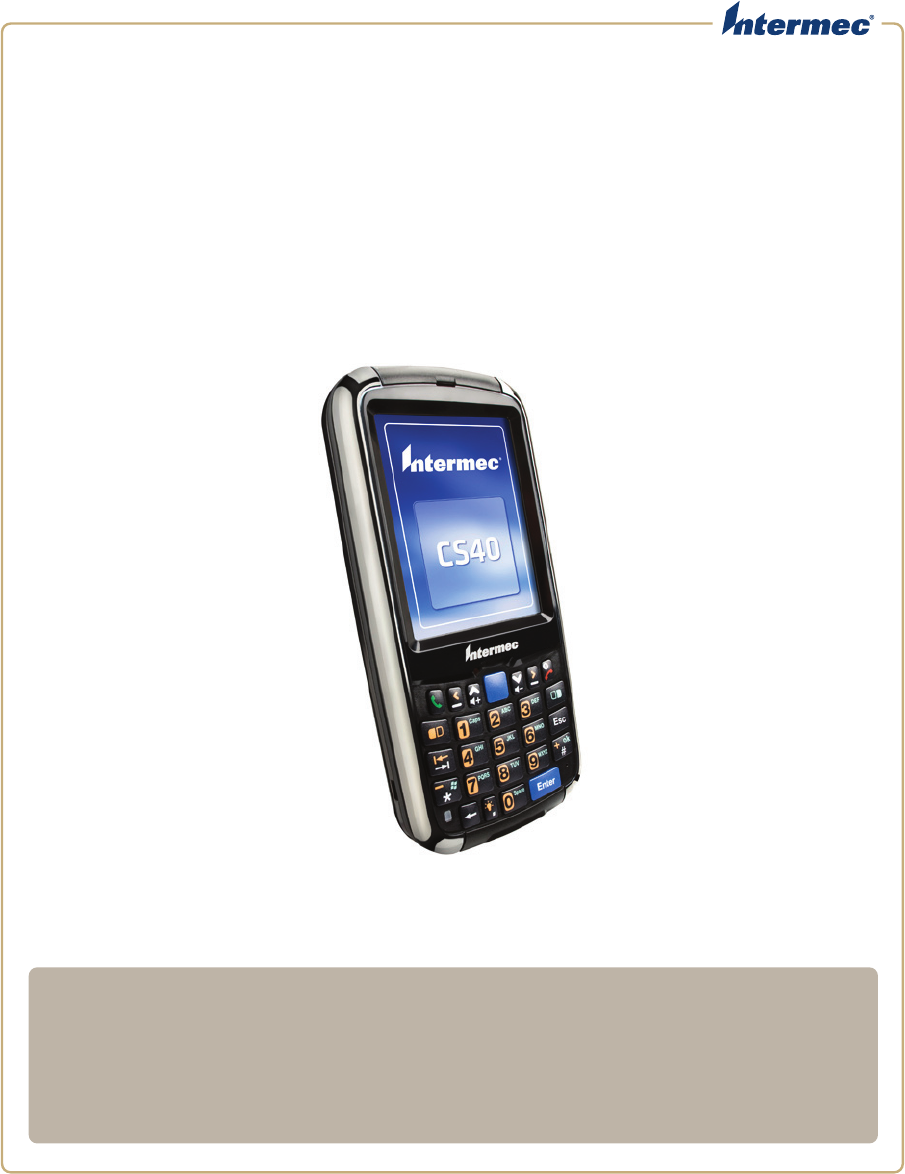
CS40
Mobile Computer
User’s Manual
ii CS40 Mobile Computer User’s Manual
Intermec Technologies Corporation
Worldwide Headquarters
6001 36th Ave.W.
Everett, WA 98203
U.S.A.
www.intermec.com
The information contained herein is provided solely for the purpose of allowing customers to
operate and service Intermec-manufactured equipment and is not to be released, reproduced, or
used for any other purpose without written permission of Intermec Technologies Corporation.
Information and specifications contained in this document are subject to change without prior
notice and do not represent a commitment on the part of Intermec Technologies Corporation.
© 2010 by Intermec Technologies Corporation. All rights reserved.
The word Intermec, the Intermec logo, Norand, ArciTech, Beverage Routebook, CrossBar,
dcBrowser, Duratherm, EasyADC, EasyCoder, EasySet, Fingerprint, i-gistics, INCA (under license),
Intellitag, Intellitag Gen2, JANUS, LabelShop, MobileLAN, Picolink, Ready-to-Work, RoutePower,
Sabre, ScanPlus, ShopScan, Smart Mobile Computing, SmartSystems, TE 2000, Trakker Antares,
and Vista Powered are either trademarks or registered trademarks of Intermec Technologies
Corporation.
There are U.S. and foreign patents as well as U.S. and foreign patents pending.
Contents
CS40 Mobile Computer User’s Manual iii
Contents
Before You Begin. . . . . . . . . . . . . . . . . . . . . . . . . . . . . . . . . . . . . . . . . . . . . . . . . . . . . . . . . . . . . . . . . vii
Safety Information . . . . . . . . . . . . . . . . . . . . . . . . . . . . . . . . . . . . . . . . . . . . . . . . . . . . . . . vii
Global Services and Support . . . . . . . . . . . . . . . . . . . . . . . . . . . . . . . . . . . . . . . . . . . . . . vii
Warranty Information. . . . . . . . . . . . . . . . . . . . . . . . . . . . . . . . . . . . . . . . . . . . vii
Web Support . . . . . . . . . . . . . . . . . . . . . . . . . . . . . . . . . . . . . . . . . . . . . . . . . . . viii
Telephone Support . . . . . . . . . . . . . . . . . . . . . . . . . . . . . . . . . . . . . . . . . . . . . viii
Service Location Support . . . . . . . . . . . . . . . . . . . . . . . . . . . . . . . . . . . . . . . . viii
Who Should Read This Manual . . . . . . . . . . . . . . . . . . . . . . . . . . . . . . . . . . . . . . . . . . . ix
Related Documents . . . . . . . . . . . . . . . . . . . . . . . . . . . . . . . . . . . . . . . . . . . . . . . . . . . . . . ix
Patent Information . . . . . . . . . . . . . . . . . . . . . . . . . . . . . . . . . . . . . . . . . . . . . . . . . . . . . . . x
1 Using the CS40. . . . . . . . . . . . . . . . . . . . . . . . . . . . . . . . . . . . . . . . . . . . . . . . . . . . . . . . . . . 1
About the CS40 Mobile Computer . . . . . . . . . . . . . . . . . . . . . . . . . . . . . . . . . . . . . . . . . . . . . . . . .2
Overview of CS40 Features. . . . . . . . . . . . . . . . . . . . . . . . . . . . . . . . . . . . . . . . . . . . . . . . . . . . . . . . . 3
CS40 Accessories. . . . . . . . . . . . . . . . . . . . . . . . . . . . . . . . . . . . . . . . . . . . . . . . . . . . . . . . . . . . . . . . . . 3
About the CS40 Battery . . . . . . . . . . . . . . . . . . . . . . . . . . . . . . . . . . . . . . . . . . . . . . . . . . . . . . . . . . . 4
Charging the Battery . . . . . . . . . . . . . . . . . . . . . . . . . . . . . . . . . . . . . . . . . . . . . . . . . . . . . .4
Replacing the Battery. . . . . . . . . . . . . . . . . . . . . . . . . . . . . . . . . . . . . . . . . . . . . . . . . . . . . .5
About Battery Status . . . . . . . . . . . . . . . . . . . . . . . . . . . . . . . . . . . . . . . . . . . . . . . . . . . . . . 6
About Battery Life and Conservation . . . . . . . . . . . . . . . . . . . . . . . . . . . . . . . . . . . . . . . 7
About the Keypad . . . . . . . . . . . . . . . . . . . . . . . . . . . . . . . . . . . . . . . . . . . . . . . . . . . . . . . . . . . . . . . . 8
About the Power Button . . . . . . . . . . . . . . . . . . . . . . . . . . . . . . . . . . . . . . . . . . . . . . . . . . . 8
Entering Characters on the QWERTY Keypad . . . . . . . . . . . . . . . . . . . . . . . . . . . . . . . 9
Entering Characters on the Numeric Keypad . . . . . . . . . . . . . . . . . . . . . . . . . . . . . . . . 9
Adjusting the Volume . . . . . . . . . . . . . . . . . . . . . . . . . . . . . . . . . . . . . . . . . . . . . . . . . . . . . . . . . . . .10
Configuring Backlight Settings . . . . . . . . . . . . . . . . . . . . . . . . . . . . . . . . . . . . . . . . . . . . . . . . . . . 11
About the Status LEDs . . . . . . . . . . . . . . . . . . . . . . . . . . . . . . . . . . . . . . . . . . . . . . . . . . . . . . . . . . .12
About the Imager . . . . . . . . . . . . . . . . . . . . . . . . . . . . . . . . . . . . . . . . . . . . . . . . . . . . . . . . . . . . . . . . 13
About Bar Codes . . . . . . . . . . . . . . . . . . . . . . . . . . . . . . . . . . . . . . . . . . . . . . . . . . . . . . . . . . . . . . . . . 13
Reading Bar Codes . . . . . . . . . . . . . . . . . . . . . . . . . . . . . . . . . . . . . . . . . . . . . . . . . . . . . . .13
About Signature Capture . . . . . . . . . . . . . . . . . . . . . . . . . . . . . . . . . . . . . . . . . . . . . . . . .15
Contents
iv CS40 Mobile Computer User’s Manual
About the Color Camera. . . . . . . . . . . . . . . . . . . . . . . . . . . . . . . . . . . . . . . . . . . . . . . . . . . . . . . . . .15
Taking a Picture . . . . . . . . . . . . . . . . . . . . . . . . . . . . . . . . . . . . . . . . . . . . . . . . . . . . . . . . . 16
Recording Video . . . . . . . . . . . . . . . . . . . . . . . . . . . . . . . . . . . . . . . . . . . . . . . . . . . . . . . . .16
Saving Pictures and Videos to an SD Card. . . . . . . . . . . . . . . . . . . . . . . . . . . . . . . . . . 17
Inserting a microSD Card. . . . . . . . . . . . . . . . . . . . . . . . . . . . . . . . . . . . . . . . . . . . . . . . . . . . . . . . .17
How to Enable the Integrated GPS on the CS40 . . . . . . . . . . . . . . . . . . . . . . . . . . . . . . . . . . . . 18
Using the GPSID Installed on the CS40 . . . . . . . . . . . . . . . . . . . . . . . . . . . . . . . . . . . . 19
Improving GPS Performance on the CS40. . . . . . . . . . . . . . . . . . . . . . . . . . . . . . . . . .20
About Additional GPS Options for the Computer . . . . . . . . . . . . . . . . . . . . . . . . . .21
2 Connecting and Configuring the CS40 . . . . . . . . . . . . . . . . . . . . . . . . . . . . . . . 23
How to Configure the CS40. . . . . . . . . . . . . . . . . . . . . . . . . . . . . . . . . . . . . . . . . . . . . . . . . . . . . . . 24
About SmartSystems Foundation . . . . . . . . . . . . . . . . . . . . . . . . . . . . . . . . . . . . . . . . . . . . . . . . . 24
How to Connect the CS40 to a PC . . . . . . . . . . . . . . . . . . . . . . . . . . . . . . . . . . . . . . . . . . . . . . . . .25
How to Connect the CS40 to Your Network . . . . . . . . . . . . . . . . . . . . . . . . . . . . . . . . . . . . . . . .25
Connecting the CS40 Using 802.11 Radio Communications . . . . . . . . . . . . . . . . .26
Connecting the CS40 Using Bluetooth Communications. . . . . . . . . . . . . . . . . . . .27
Connecting the CS40 to a Wireless Printer . . . . . . . . . . . . . . . . . . . . . . . . . . . . . . . . .28
Connecting the CS40 Using Ethernet Communications . . . . . . . . . . . . . . . . . . . . .29
Connecting the CS40 Using USB Communications . . . . . . . . . . . . . . . . . . . . . . . . . 30
About the Phone . . . . . . . . . . . . . . . . . . . . . . . . . . . . . . . . . . . . . . . . . . . . . . . . . . . . . . . . . . . . . . . . . 30
Turning On the Phone Using the Wireless Manager. . . . . . . . . . . . . . . . . . . . . . . . .31
Activating the UMTS Radio. . . . . . . . . . . . . . . . . . . . . . . . . . . . . . . . . . . . . . . . . . . . . . .31
Making a Phone Call . . . . . . . . . . . . . . . . . . . . . . . . . . . . . . . . . . . . . . . . . . . . . . . . . . . . .32
Connecting to an ISP. . . . . . . . . . . . . . . . . . . . . . . . . . . . . . . . . . . . . . . . . . . . . . . . . . . . . . . . . . . . .32
Connecting to a Network With a VPN Server . . . . . . . . . . . . . . . . . . . . . . . . . . . . . . . . . . . . . . .34
3 Developing and Installing Applications . . . . . . . . . . . . . . . . . . . . . . . . . . . . . 35
How to Develop Applications for the CS40 . . . . . . . . . . . . . . . . . . . . . . . . . . . . . . . . . . . . . . . . . 36
How to Package Your Application . . . . . . . . . . . . . . . . . . . . . . . . . . . . . . . . . . . . . . . . .36
How to Choose a Target Location . . . . . . . . . . . . . . . . . . . . . . . . . . . . . . . . . . . . . . . . . 36
Contents
CS40 Mobile Computer User’s Manual v
How to Install Applications on the CS40 . . . . . . . . . . . . . . . . . . . . . . . . . . . . . . . . . . . . . . . . . . .37
Installing Applications Using SmartSystems Foundation Console. . . . . . . . . . . .37
Installing Applications Using Microsoft ActiveSync or
Windows Mobile Device Center. . . . . . . . . . . . . . . . . . . . . . . . . . . . . . . . . . . . . . . . .38
How to Install Applications Using a Scan-to-Connect Bar Code . . . . . . . . . . . . . .38
Installing Applications Using a microSD Card. . . . . . . . . . . . . . . . . . . . . . . . . . . . . .38
How to Update the System Software . . . . . . . . . . . . . . . . . . . . . . . . . . . . . . . . . . . . . . . . . . . . . . .39
Updating Multiple CS40s Using SmartSystems Console. . . . . . . . . . . . . . . . . . . . .40
How to Send Silent Update Packages to the Computer . . . . . . . . . . . . . . . . . . . . . . 41
Updating Individual CS40s . . . . . . . . . . . . . . . . . . . . . . . . . . . . . . . . . . . . . . . . . . . . . . . 41
4 Troubleshooting and Maintaining the Computer . . . . . . . . . . . . . . . . . . 43
Calling Product Support. . . . . . . . . . . . . . . . . . . . . . . . . . . . . . . . . . . . . . . . . . . . . . . . . . . . . . . . . .44
Troubleshooting the Computer . . . . . . . . . . . . . . . . . . . . . . . . . . . . . . . . . . . . . . . . . . . . . . . . . . .45
Resetting the Computer . . . . . . . . . . . . . . . . . . . . . . . . . . . . . . . . . . . . . . . . . . . . . . . . . . . . . . . . . . 50
Warm Booting the Computer . . . . . . . . . . . . . . . . . . . . . . . . . . . . . . . . . . . . . . . . . . . . . 50
Cold Booting the Computer . . . . . . . . . . . . . . . . . . . . . . . . . . . . . . . . . . . . . . . . . . . . . . 50
Clean Booting the Computer . . . . . . . . . . . . . . . . . . . . . . . . . . . . . . . . . . . . . . . . . . . . .51
Cleaning the Computer. . . . . . . . . . . . . . . . . . . . . . . . . . . . . . . . . . . . . . . . . . . . . . . . . . . . . . . . . . .52
A Specifications . . . . . . . . . . . . . . . . . . . . . . . . . . . . . . . . . . . . . . . . . . . . . . . . . . . . . . . . . 53
Physical and Environmental Specifications. . . . . . . . . . . . . . . . . . . . . . . . . . . . . . . . . . . . . . . . . 54
CS40 Micro-AB USB Connector Specifications . . . . . . . . . . . . . . . . . . . . . . . . . . . . .58
CS40 Docking Connector Specifications . . . . . . . . . . . . . . . . . . . . . . . . . . . . . . . . . . . 58
EA11 Imager Reading Distances. . . . . . . . . . . . . . . . . . . . . . . . . . . . . . . . . . . . . . . . . . . . . . . . . . .56
B Default Settings . . . . . . . . . . . . . . . . . . . . . . . . . . . . . . . . . . . . . . . . . . . . . . . . . . . . . . . 59
Default Configuration . . . . . . . . . . . . . . . . . . . . . . . . . . . . . . . . . . . . . . . . . . . . . . . . . . . . . . . . . . . 60
C Keypads and Keystrokes. . . . . . . . . . . . . . . . . . . . . . . . . . . . . . . . . . . . . . . . . . . . . . 65
Standard Characters . . . . . . . . . . . . . . . . . . . . . . . . . . . . . . . . . . . . . . . . . . . . . . . . . . . . . . . . . . . . .66
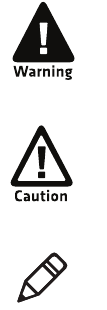
Before You Begin
CS40 Mobile Computer User’s Manual vii
Before You Begin
This section provides you with safety information, technical support
information, and sources for additional product information.
Safety Information
Your safety is extremely important. Read and follow all warnings and
cautions in this document before handling and operating Intermec
equipment. You can be seriously injured, and equipment and data can
be damaged if you do not follow the safety warnings and cautions.
This section explains how to identify and understand warnings,
cautions, and notes that are in this document.
Global Services and Support
Warranty Information
To understand the warranty for your Intermec product, visit the
Intermec web site at www.intermec.com and click Support >
Returns and Repairs > Warranty.
Disclaimer of warranties: The sample code included in this document
is presented for reference only. The code does not necessarily
represent complete, tested programs. The code is provided “as is with
all faults.” All warranties are expressly disclaimed, including the
implied warranties of merchantability and fitness for a particular
purpose.
A warning alerts you of an operating procedure, practice,
condition, or statement that must be strictly observed to avoid
death or serious injury to the persons working on the equipment.
A caution alerts you to an operating procedure, practice,
condition, or statement that must be strictly observed to prevent
equipment damage or destruction, or corruption or loss of data.
Note: Notes either provide extra information about a topic or contain
special instructions for handling a particular condition or set of
circumstances.
Before You Begin
viii CS40 Mobile Computer User’s Manual
Web Support
Visit the Intermec web site at www.intermec.com to download our
current manuals (in PDF). To order printed versions of the Intermec
manuals, contact your local Intermec representative or distributor.
Visit the Intermec technical knowledge base (Knowledge Central) at
www.intermec.com and click Support > Knowledge Central to
review technical information or to request technical support for your
Intermec product.
Telephone Support
In the U.S.A. and Canada, call 1-800-755-5505.
Outside the U.S.A. and Canada, contact your local Intermec
representative. To search for your local representative, from the
Intermec web site, click About Us > Contact Us.
Service Location Support
For the most current listing of service locations, click Support
>Returns and Repairs > Repair Locations.
For technical support in South Korea, use the after service locations
listed below:
AWOO Systems
102-1304 SK Ventium
522 Dangjung-dong
Gunpo-si, Gyeonggi-do Korea, South 435-776
Contact: Mr. Sinbum Kang
Telephone: +82-31-436-1191
Email: mjyun@awoo.co.kr
IN Information System PTD LTD
6th Floor
Daegu Venture Center Bldg 95
Shinchun 3 Dong
Donggu, Daegu City, Korea
E-mail: jmyou@idif.co.kr or korlim@gw.idif.co.kr
Before You Begin
CS40 Mobile Computer User’s Manual ix
Who Should Read This Manual
This manual is written for the person who is responsible for
installing, configuring, and maintaining the CS40 Mobile Computer.
This manual provides you with information about the features of the
CS40, and how to install, configure, operate, maintain, and
troubleshoot it.
Before you work with the CS40, you should be familiar with your
network and general networking terms, such as IP address.
Related Documents
You may find these related software and programming documents
useful:
•Intermec Settings Command Reference Manual
•Intermec Developer Library (IDL) Resource Kit Developer’s Guide
•Intermec Browser User’s Manual
•Intermec Launcher User’s Manual
•Intermec Connection Manager User’s Guide
The Intermec web site at www.intermec.com contains our
documents (as PDF files) that you can download for free.
To download documents
1Visit the Intermec web site at www.intermec.com.
2Click the Products tab.
3Using the Products menu, navigate to your product page. For
example, to find the CS40 computer product page, click
Computers > Handheld Computers > CS40.
4Click the Manuals tab.
If your product does not have its own product page, click Support >
Manuals. Use the Product Category field, the Product Family field,
and the Product field to help you locate the documentation for your
product.
Before You Begin
x CS40 Mobile Computer User’s Manual
Patent Information
Product is covered by one or more of the following patents:
5,155,659; 5,243,602; 5,278,487; 5,289,378; 5,305,181; 5,308,966;
5,317,691; 5,319,184; 5,322,991; 5,324,925; 5,327,308; 5,331,580;
5,342,210; 5,345,146; 5,347,115; 5,349,497; 5,349,678; 5,359,185;
5,362,953; 5,363,031; 5,371,858; 5,389,770; 5,397,885; 5,401,591;
5,401,592; 5,404,493; 5,408,382; 5,410,141; 5,413,529; 5,414,251;
5,416,463; 5,440,315; 5,442,167; 5,457,629; 5,463,305; 5,464,972;
5,465,207; 5,466,170; 5,468,945; 5,468,947; 5,468,948; 5,468,950;
5,473,242; 5,477,044; 5,486,689; 5,487,161; 5,493,199; 5,500,516;
5,502,297; 5,504,367; 5,510,589; 5,514,858; 5,515,215; 5,517,373;
5,517,434; 5,521,370; 5,534,684; 5,536,124; 5,536,924; 5,539,191;
5,541,419; 5,544,010; 5,548,108; 5,548,201; 5,550,362; 5,550,364;
5,553,084; 5,554,822; 5,555,459; 5,557,092; 5,563,748; 5,565,669;
5,568,016; 5,568,645; 5,576,529; 5,576,601; 5,576,981; 5,587,577;
5,598,007; 5,598,082; 5,608,578; 5,616,909; 5,625,555; 5,627,360;
5,630,090; 5,631,539; 5,640,001; 5,644,471; 5,659,431; 5,671,436;
5,672,860; 5,682,299; 5,684,290; 5,694,318; 5,710,728; 5,714,812;
5,717,313; 5,719,678; 5,726,937; 5,733,673; 5,736,725; 5,747,785;
5,747,938; 5,764,798; 5,773,159; 5,777,309; 5,780,992; 5,786,583;
5,795,664; 5,796,359; 5,798,513; 5,798,610; 5,802,379; 5,805,416;
5,805,474; 5,811,776; 5,811,777; 5,811,828; 5,818,027; 5,818,199;
5,821,523; 5,828,052; 5,834,749; 5,834,753; 5,834,760; 5,838,471;
5,841,402; 5,841,403; 5,842,070; 5,844,222; 5,854,478; 5,856,737;
5,862,267; 5,869,840; 5,872,354; 5,873,070; 5,877,486; 5,878,395;
5,886,338; 5,889,818; 5,892,971; 5,895,906; 5,896,214; 5,898,290;
5,902,987; 5,902,988; 5,912,452; 5,912,547; 5,914,585; 5,923,022;
5,936,224; 5,939,700; 5,943,421; 5,961,337; 5,969,326; 5,969,328;
5,969,502; 5,973,645; 5,979,768; 5,987,192; 5,987,499; 5,992,750;
5,992,751; 5,996,080; 5,996,896; 6,003,773; 6,003,775; 6,012,638;
6,012,640; 6,012,939; 6,016,960; 6,018,597; 6,024,289; 6,026,027;
6,031,524; 6,034,379; 6,036,093; 6,037,919; 6,039,252; 6,039,258;
6,042,414; 6,049,813; 6,052,279; 6,053,759; 6,058,000; 6,061,155;
6,064,763; 6,076,731; 6,091,227; 6,094,029; 6,095,422; 6,097,839;
6,102,266; 6,102,289; 6,102,295; 6,109,528; 6,112,206; 6,113,047;
6,119,941; 6,124,800; 6,128,414; 6,131,815; 6,135,810; 6,137,260;
6,149,059; 6,149,061; 6,149,063; 6,152,370; 6,155,490; 6,158,661;
6,161,123; 6,163,359; 6,164,542; 6,164,545; 6,173,893; 6,174,180;
Before You Begin
CS40 Mobile Computer User’s Manual xi
6,177,926; 6,186,406; 6,199,044; 6,204,632; 6,204,825; 6,212,401;
6,213,400; 6,229,408; 6,234,393; 6,234,395; 6,236,186; 6,236,486;
6,243,258; 6,249,008; 6,259,044; 6,292,437; 6,295,461; 6,307,349;
6,321,986; 6,328,214; 6,330,972; 6,330,974; 6,330,975; 6,345,765;
6,356,949; 6,367,699; 6,375,076; 6,398,105; 6,404,325; 6,435,411;
6,478,223; 6,484,944; 6,488,209; 6,497,368; 6,532,152; 6,538,413;
6,539,064; 6,539,422; 6,641,046; 6,669,087; 6,687,403; 6,691,922;
6,694,359; 6,701,361; 6,724,510; 6,731,713; 6,732,930; 6,776,342;
6,857,013; 6,879,428; 6,897,776; 6,944,446; 6,967,280; 6,970,459;
6,976,062; 7,027,037; 7,034,659; 7,035,466; 7,090,137; 7,095,383;
7,117,374; 7,125,743; 7,139,870; 7,143,941; 7,152,797; 7,159,764;
7,180,640; 7,184,068; 7,185,819; 7,190,835; 7,206,338; 7,208,916;
7,210,633; 7,232,072; 7,249,302; 7,271,679; 7,296,749; 7,298,791;
7,325,741; 7,327,988; 7,347,375; 7,360,705; 7,392,951; 7,407,105;
7,411,501; 7,412,097; 7,413,125; 7,417,809; 7,418,157; 7,427,912;
7,444,516; 7,451,441; 7,451,931; 7,451,933
There may be other U.S. and foreign patents pending.
Before You Begin
xii CS40 Mobile Computer User’s Manual

1
1
Using the CS40
This chapter introduces the CS40 Mobile Computer with
Windows® Mobile® 6.5 and describes the basic features of the
computer. This chapter contains these topics:
•About the CS40 Mobile Computer
•Overview of CS40 Features
•CS40 Accessories
•About the CS40 Battery
•About the Keypad
•Adjusting the Volume
•Configuring Backlight Settings
•About the Status LEDs
•About the Imager
•About Bar Codes
•About the Color Camera
•Inserting a microSD Card
•How to Enable the Integrated GPS on the CS40
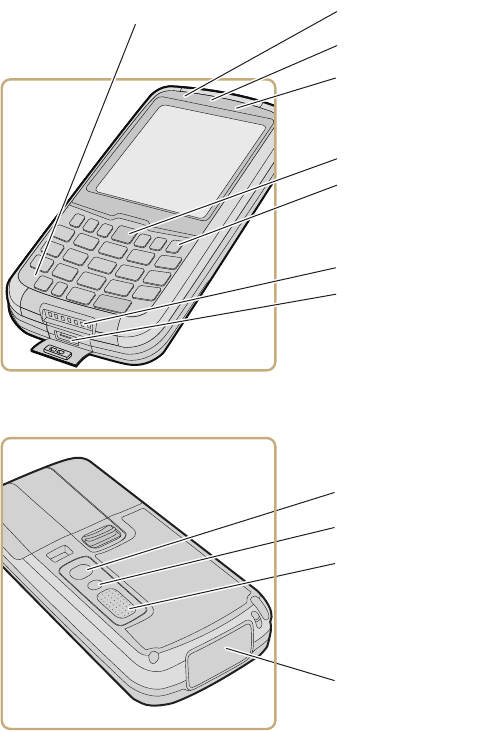
Chapter 1 — Using the CS40
2 CS40 Mobile Computer User’s Manual
About the CS40 Mobile Computer
The Intermec CS40 Mobile Computer is a small, lightweight mobile
computer built on the Microsoft® Windows® Mobile 6.5 operating
system. This Personal Digital Assistant PDA-style mobile computer
supports the latest High Speed Uplink Packet Access (HSUPA).
CS40 Front View
CS40 Back View
USB connector
Docking connector
Scan button
On/O
Notification LED
Key Status LED
Battery Status LED
Good Read LED
Camera
Flash
Speaker
Imager
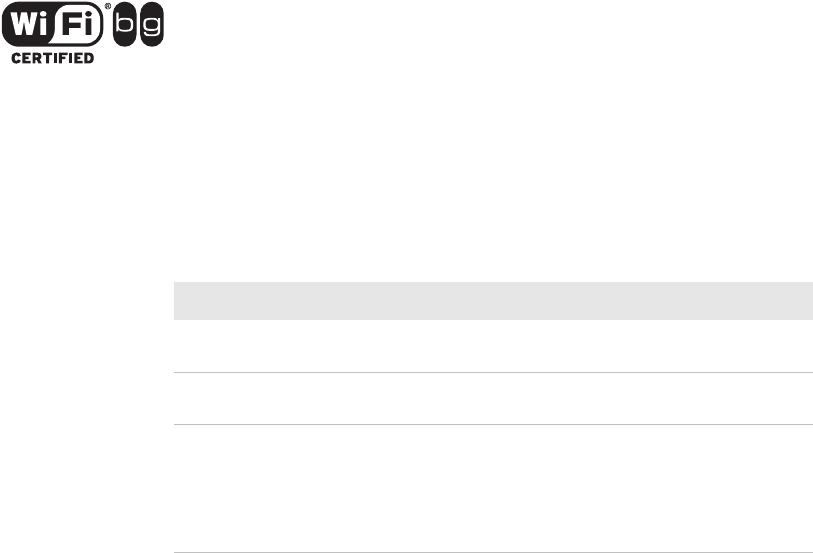
Chapter 1 — Using the CS40
CS40 Mobile Computer User’s Manual 3
Overview of CS40 Features
The CS40 includes these standard features:
•EA11 area imager that can read bar codes and capture signatures
•Multi-processor architecture with 256 MB DRAM and 512 MB
Flash (approximately 350 MB free for custom applications)
•3.75G UMTS (with EDGE, GPRS, and GSM fallback), 802.11b/g,
and Bluetooth® radio
•Integrated GPS receiver
•3-megapixel color camera
•Customer-accessible micro-SD slot for removable memory cards
up to 32 GB
•Customer-accessible SIM card slot
•Numeric or QWERTY keypad
CS40 Accessories
The CS40 accessories are sold and ordered separately. For help,
contact your local Intermec sales representative.
The CS40 Mobile Computer with an IEEE 802.11b/g radio installed
is Wi-Fi® certified for interoperability with other 802.11b/g wireless
LAN devices.
CS40 Accessories
Accessory Description
CS40 Battery (Model
1005AB01)
The battery provides main power to the CS40.
Universal Cell Phone
Charger
Use the universal cell phone charger to provide power
to your CS40 from an external power supply.
DX1 Desktop Dock
(Model 1002UU02)
Use the desktop dock with the:
•CS40 cup (Model 1002UC06) to charge the battery
while it is installed in the CS40.
•CS40 battery cup (Model 1002UC05) to charge the
battery.
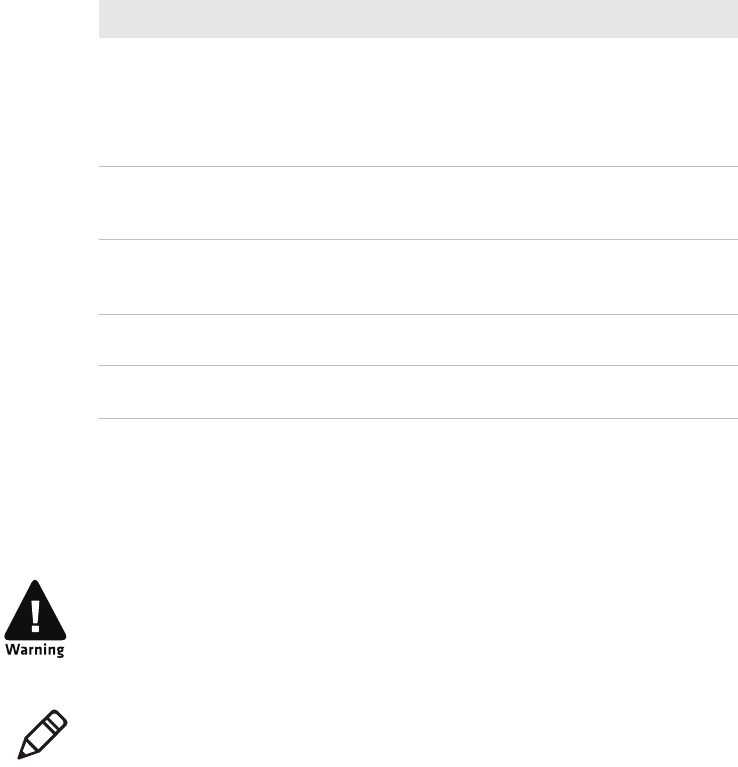
Chapter 1 — Using the CS40
4 CS40 Mobile Computer User’s Manual
About the CS40 Battery
The CS40 uses a battery pack (Model 1005AB01) as its main power
source.
Charging the Battery
You need to fully charge the battery before using your CS40 for the
first time.
DX2 Dual Base
(Model 1002UU01)
and DX4 Quad Base
(Model 1002UU03)
Use these charger bases with the:
•CS40 cup (Model 1002UC06) to charge two or
four batteries while they are installed in the CS40.
•CS40 battery cup (Model 1002UC05) to charge
charge two or four batteries.
Vehicle Power
Adapter (Model
9005AX01)
Use the vehicle power adapter to provide power to the
CS40 from your vehicle.
Power and Data
Y-Cable
Use the power and data y-cable to provide power to
your CS40 from an external power supply and
provide USB communications with your PC.
Vehicle Holder Use the vehicle holder to hold your CS40 while you
are using it in a vehicle.
Holster and Purse
Holster
Use the holster accessories to carry your CS40 when
you are not using it.
CS40 Accessories (continued)
Accessory Description
The battery used in this device may present a fire or chemical
burn hazard if it is mistreated. Do not disassemble it, heat it
above 100°C (212°F) or incinerate it. Dispose of used batteries
promptly. Keep away from children.
Note: If the CS40 is not using external power and you remove the
battery pack, the CS40 goes into a power off state and then cold boots.
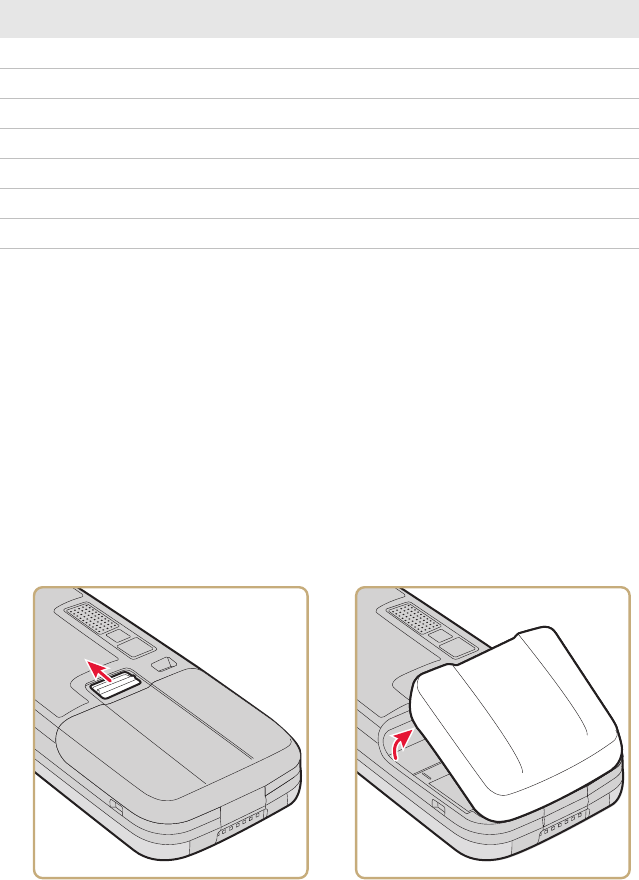
Chapter 1 — Using the CS40
CS40 Mobile Computer User’s Manual 5
To charge the battery
•Use one of the charging accessories listed in the next table.
Replacing the Battery
The CS40 resets when you remove the battery.
To replace the battery
1Save your files and close any open applications.
2Tap Start > Shutdown to turn off the CS40.
3Push the battery release tab forward until the battery releases, and
lift the battery away from the CS40.
Charging Times for the CS40 Battery
Accessory Charging Time
Universal cell phone charger 4 hours
DX1 desktop dock and CS40 cup 6 hours
DX1 desktop dock and CS40 battery cup 6 hours
DX2 or DX4 base and CS40 cup 6 hours
DX2 or DX4 base and CS40 battery cup 6 hours
Vehicle power adapter
Data and power y-cable variable*
* When you charge your CS40 from your PC, the charge time depends on
the amount of power provided by the USB port on your PC.
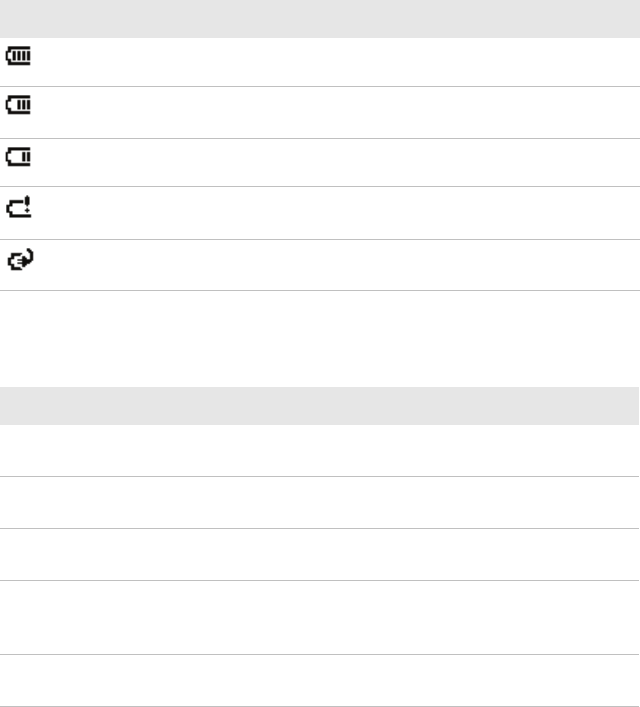
Chapter 1 — Using the CS40
6 CS40 Mobile Computer User’s Manual
4Insert the bottom of a fully charged battery into the CS40, and
press down firmly on the top of the battery. Make sure that the
battery release tab is fully engaged.
About Battery Status
Use the battery icon to see the power status of your battery.
Use the battery status LED to see the charging status of your battery.
Battery Icon Status
Icon Status
Battery is fully charged.
Battery has a medium charge. You should be able to work for several
more hours before changing batteries.
Battery is low. You need to charge or replace the battery soon.
Battery is critically low. You need to replace the battery now.
Battery is charging.
Battery Status LED States
LED State Description
Steady green The CS40 is connected to a charger and the battery is more
than 95% charged.
Blinking red The battery is low. The CS40 goes into Suspend mode.
Charge or replace the battery.
Steady red The CS40 is connected to a charger and the battery is
charging.
Steady amber There is a battery error. The battery may be outside the
allowable charging temperature or you may need to replace
the battery.
Off The CS40 is not on external power and the battery is
operating normally.

Chapter 1 — Using the CS40
CS40 Mobile Computer User’s Manual 7
About Battery Life and Conservation
Batteries that are stored outside the CS40 for long periods of time
slowly discharge. Intermec recommends storing the battery in a
charger to maintain battery performance.
Battery Conservation Tips
When You Want To: Do This to Save Battery Power:
Use the CS40 and the Low
Battery status icon appears
or the Battery light comes
on.
•Connect the CS40 to an external power
source.
•Or, save your data and tap Start >
Shutdown. After the CS40 turns off,
remove the battery and insert a fully
charged battery.
Stop using the CS40 for
5 minutes or longer.
Make sure the low battery icon is not on the
screen and the Battery light is not turned on.
Press and hold the Power button for about
2 seconds to suspend the CS40.
Store the CS40 for more
than a day.
If you are storing the CS40 for a few days, such
as over the weekend, install a charged battery
or connect the CS40 to a power source.
If you are storing the CS40 for longer, remove
and charge the battery, and then store both
the battery and CS40 in a cool location. If you
store the battery for several months, recharge
the battery to keep it at peak performance.
Store the battery outside the
CS40.
Store the batteries in a charger.
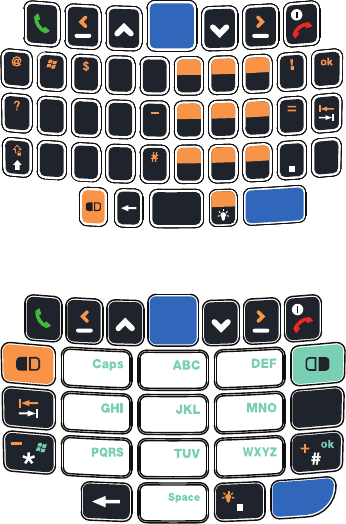
Chapter 1 — Using the CS40
8 CS40 Mobile Computer User’s Manual
About the Keypad
The CS40 comes with either a QWERTY or numeric keypad.
CS40 QWERTY Keypad
CS40 Numeric Keypad
About the Power Button
When you press and hold the Power button for about 2 seconds, you
put the CS40 into suspend mode. In this lower power mode, the CS40
continues to supply power to all memory, but turns off power to most
hardware, such as the display. This power-saving feature is designed to
prolong battery life.
Enter
Space
C
X
ZVBNM
F
D
S
AGHJKL
R
E
W
QTYIOP
U
123
456
78
0
9
Esc
‘
:
/
sym
%
+
’*
&
Esc
Enter
4
1
7
2
5
8
0
3
6
9
Chapter 1 — Using the CS40
CS40 Mobile Computer User’s Manual 9
Entering Characters on the QWERTY Keypad
You need to use the orange modifier key b and the Shift key [ to
access all characters and functions.
To type a character
•Press the key for the character.
To type a character or access a function on the overlay
1Press b. The key status LED turns orange.
2Press the key for the character or function.
To only type characters or access functions on the overlay
•Press b twice. The key status LED turns orange and stays on.
To type uppercase letters
1Press b [ to turn on Caps Lock. The key status LED turns green.
2Press the key for the character.
Caps Lock stays on until you press b [ again.
While Caps Lock is on:
•you can type orange modifier characters by pressing b and the
key for that character.
•you can type lowercase letters by pressing [ and the key for the
character.
For information on how to enter specific characters with keystrokes,
see Appendix C, “Keypads and Keystrokes.”
Entering Characters on the Numeric Keypad
You need to use the orange modifier key b and the green modifier key
c to access all characters and functions.
To type a character
•Press the key for the character.
Chapter 1 — Using the CS40
10 CS40 Mobile Computer User’s Manual
To type a character or access a function in orange on the overlay
1Press b. The key status LED turns orange.
2Press the key for the character or function.
The orange modifier key stays on until you press b again.
To type lowercase letters
1Press c. The key status LED turns green.
2Press the corresponding number key as many times as necessary
depending on the position of the letter you want to type.
For example, to type a lowercase letter z, press c9999.
To type uppercase letters
1Press c 1 to turn on Caps Lock. The key status LED turns green.
2Press the number key as many times as necessary depending on the
position of the letter you want to type.
Caps Lock stays on until you press c 1 again.
While Caps Lock is on:
•you can type orange modifier characters by pressing b and the
key for that character.
•you can type lowercase letters by pressing c and the
corresponding number key as many times as necessary
depending on the position of the letter you want to type.
For information on how to enter specific characters with keystrokes,
see Appendix C, “Keypads and Keystrokes.”
Adjusting the Volume
You can adjust the computer volume for your needs and your
environment. The volume includes sounds you hear when you tap the
screen or read bar codes with the imager. You can set the volume to
off, very low, low, medium, high, very high (default), or vibrate.
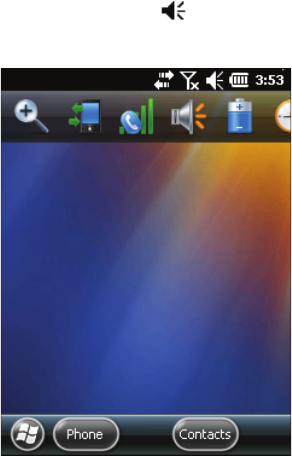
Chapter 1 — Using the CS40
CS40 Mobile Computer User’s Manual 11
To adjust the volume
1Tap the Volume ( ) icon at the top of the screen, and then tap
the volume icon from the menu.
2Use your stylus or the u and d keys to adjust the volume slider to
the volume you want, select Vibrate, or select Off.
Configuring Backlight Settings
You can turn on the backlight to see the screen better, or you can turn
off the backlight to help conserve battery power.
To turn the backlight on and off
•If you have a QWERTY keypad, press f.
•If you have a numeric keypad, press b ..
By default, the CS40 goes into Screen Off mode when there is no
activity. Screen Off mode turns off the backlight and display. Press a
key or tap the screen to resume activity.
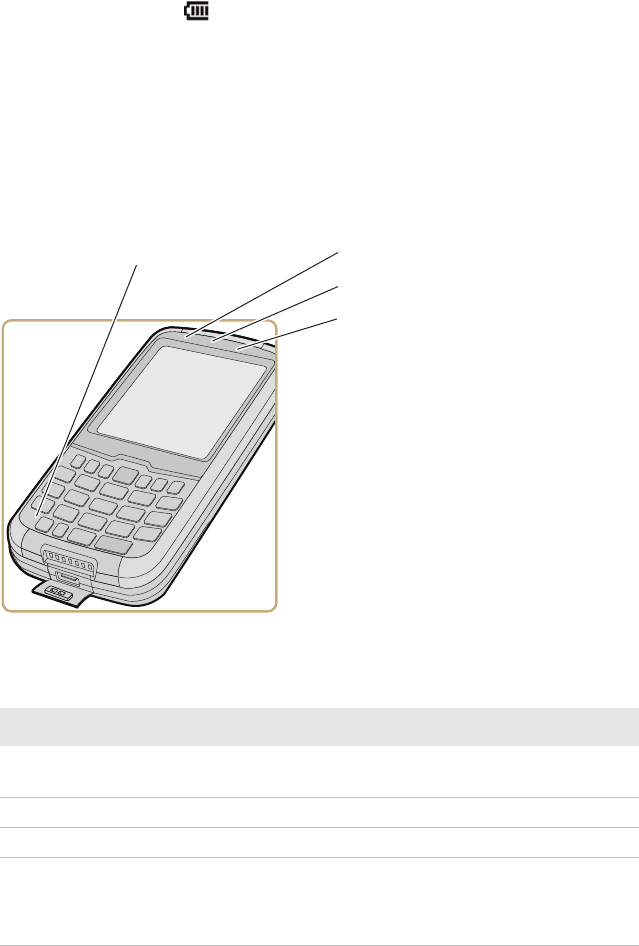
Chapter 1 — Using the CS40
12 CS40 Mobile Computer User’s Manual
To configure the backlight
1Tap the Battery ( ) icon at the top of the screen, and then tap the
battery icon from the menu.
2With Turn off backlight if device is not used for checked, select
the timeout value (30 seconds, or 1 to 5 minutes).
About the Status LEDs
The CS40 has four status LEDs.
Location of the Status LEDs
Status LED Descriptions
LED Color Description
Notification Amber The computer is notifying you of a pending alarm
or message.
Good Read Green The computer has successfully decoded a bar code.
Battery See “About Battery Status” on page6.
Key Status Green Caps Lock is enabled (QWERTY keypad).
Green function keys are enabled (numeric keypad).
Amber Orange function keys are enabled.
Notification LED
Key Status LED
Battery Status LED
Good Read LED

Chapter 1 — Using the CS40
CS40 Mobile Computer User’s Manual 13
About the Imager
The CS40 uses an area imager to perform these tasks:
•Read bar codes, including 1D, 2D, and composite symbologies and
postal codes.
•Capture signatures. Use the imager to “photograph” signatures on
business forms, or to capture onscreen signatures or line drawings.
About Bar Codes
To easily enable or disable bar code symbologies, read one of the bar
codes in the table, “Symbology Bar Codes” on page73.
You can use EasySet to create configuration bar codes specific to your
system. You can download a free copy of EasySet from the CS40 web
page on the Intermec web site at www.intermec.com.
To develop an application you can use to configure the imager, use
the Data Collection Resource Kit. The resource kit is part of the
Intermec Developer Library (IDL) and can be downloaded from the
Intermec web site at www.intermec.com/idl.
Reading Bar Codes
Use the imager to scan 1D and 2D bar code symbologies, composite
symbologies, and postal codes. You can position the CN4 in almost
any orientation to scan a bar code label.
Note: When the Pictures & Videos application is running, you cannot
use the imager.
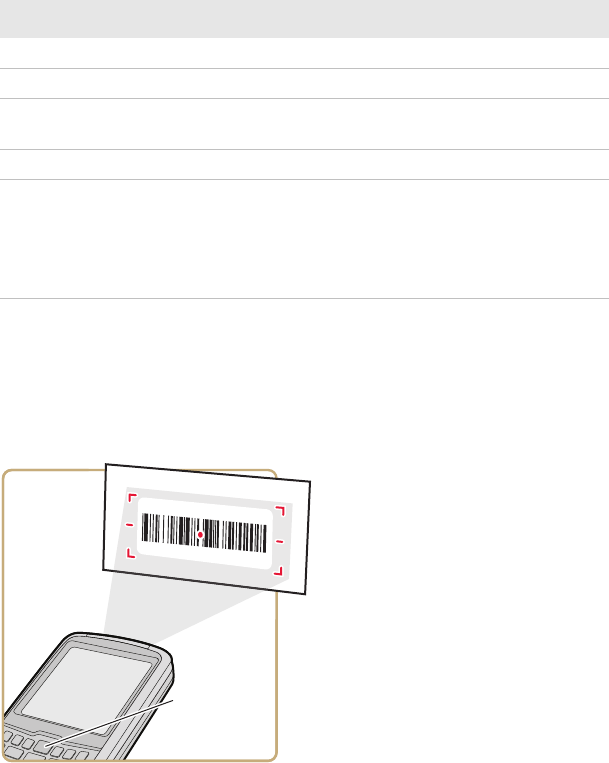
Chapter 1 — Using the CS40
14 CS40 Mobile Computer User’s Manual
To read a bar code
1Enable only the bar code symbologies that you need.
2Use Intermec Settings to choose the predefined imager mode that
best suits your environment:
3Point the imager window at the bar code label, and hold the CS40
steady a few inches from the label.
4Press the Scan button. The laser pointer and illumination beam
and frame appear.
Predefined Mode For Scanning
1D Only 1D labels.
1D and 2D Standard (Default) All types of bar code labels.
1D and 2D Bright Environment In high ambient light, such as
outdoors in the sunshine.
1D and 2D Reflective Surface Glossy labels.
Custom In conditions that require customized
settings. For complete information
about these settings, commands, and
parameters, see the Intermec Settings
Command Reference Manual.
Scan button

Chapter 1 — Using the CS40
CS40 Mobile Computer User’s Manual 15
5Use the laser pointer as a guide and aim toward the middle of the
bar code. Make sure that the illumination frame covers the bar
code you are trying to decode.
When the CS40 successfully reads a bar code label, the Good Read
LED turns on briefly.
6Release the Scan button.
About Signature Capture
A signature capture is a grayscale image of a signature on paper or
other business form. To use signature capture in your applications,
use the SignatureCapture components in the Data Collection
Resource Kit.
Ink capture is the process of saving an onscreen image, such as a
signature or simple line drawing, to a file. To use ink capture in your
applications, use the InkCapture components in the Mobile Gadgets
Resource Kit.
Both Resource Kits are part of the Intermec Developer Library (IDL)
which you can download from the Intermec web site at
www.intermec.com/idl.
About the Color Camera
You can use the color camera to:
•take, view, and edit pictures.
•record and launch video clips stored on the CS40 or a microSD
card.
•configure camera options.
You can also send pictures and video clips to others or save an image
as the background on the Today screen.
Note: While the Pictures & Videos application is running, you cannot
use the imager.
Chapter 1 — Using the CS40
16 CS40 Mobile Computer User’s Manual
Taking a Picture
You can take photos in high, normal, or low quality, with image sizes
up to 2048 x 1536 pixels. When you take a picture, the image is saved
as a .jpg file and stored in the /My Documents/My Pictures folder.
To take a picture with the camera
1Tap Start > Pictures & Videos.
2Tap the Camera icon, the Camera button, or press Enter.
3Using the screen as a viewfinder, move the camera until you have
the image you want to capture.
Press u to zoom in, or press d to zoom out.
4Tap Take Pic or press Enter to take and save the picture. If you
choose to save your pictures to Main memory, they are saved to
permanent storage on the CS40.
Recording Video
You need to switch to video mode to record video. When you record
video, the video is saved as an .mp4 file and stored in the /My
Documents/My Pictures folder.
To switch to Video mode and record video
1Tap Start > Pictures & Videos.
2Tap the Camera icon, the Camera button, or press Enter.
3Tap Menu > Video. The camera icon in the lower right corner
turns into a video camera, and the Record button replaces the
Take Pic button.
4Using the screen as a viewfinder, move the camera until you see the
scene you want to record.
Press u to zoom in, or press d to zoom out.
5Tap Record or press Enter to start recording.
6When you are done, tap Stop or press Enter to stop recording and
save the video. If you choose to save your videos to Main memory,
they are saved to permanent storage on the CS40.
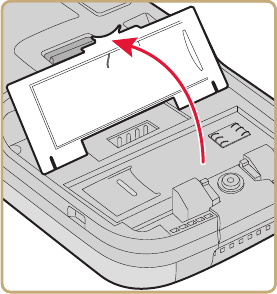
Chapter 1 — Using the CS40
CS40 Mobile Computer User’s Manual 17
Saving Pictures and Videos to an SD Card
Pictures and videos are automatically saved to the main memory on
your CS40. You can save your pictures and video to an SD card to
easily transport them to another device.
To save picture and video files to an SD card
1Install a miniSD card.
2Tap Start > Pictures & Videos.
3Tap the camera icon.
4Tap Menu > Settings.
5From the Save file to list, select SD card, and tap OK.
Inserting a microSD Card
You can use a microSD card to increase file storage and install
software. The CS40 supports an optional 32 GB maximum capacity
microSD™ card.
To install a microSD card
1Tap Start > Shutdown to turn off the CS40.
2Push the battery release tab forward until the battery releases, and
lift the battery away from the CS40.
3Open the card access door.
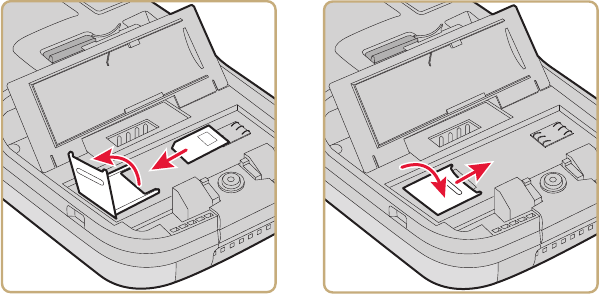
Chapter 1 — Using the CS40
18 CS40 Mobile Computer User’s Manual
4Slide the microSD card door to the left to unlock it and open the
door.
5Slide the microSD card into place.
6Close the microSD card door and slide it to the right to lock it in
place.
7Close the card access door.
8Install the battery.
9Press the Power button. The CS40 cold boots.
How to Enable the Integrated GPS on the CS40
The CS40 comes equipped with an integrated Global Positioning
System (GPS) receiver. It can deliver standards-based National Marine
Electronics Association (NMEA) data strings to GPS applications.
Intermec recommends that you use the GPS Intermediate Driver
(GPSID) instead of directly accessing the GPS hardware. The GPSID
is a Microsoft software component that interacts between
applications and the GPS hardware.
Using the GPSID allows Intermec support for Extended Ephemeris,
which enhances GPS performance by:
•reducing the amount of time it takes your GPS receiver to acquire
a fix.
•eliminating the need to obtain precise satellite data information
from the GPS satellites.
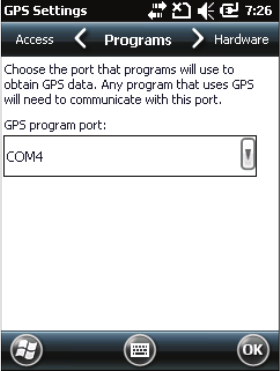
Chapter 1 — Using the CS40
CS40 Mobile Computer User’s Manual 19
And, as a Microsoft software component, the GPSID also provides
these benefits:
•Allows multiple applications to simultaneously access the GPS
data stream.
•Provides access to GPS data without requiring applications to
recognize and parse NMEA syntax.
Using the GPSID Installed on the CS40
To use the GPSID installed on your computer, you need to configure
the GPSID settings.
To configure your GPSID settings
1Tap Start > Settings > System > External GPS. The GPS Settings
screen appears with Programs selected.
2Select the COM port that you want your programs to use to get
GPS data from your CS40.
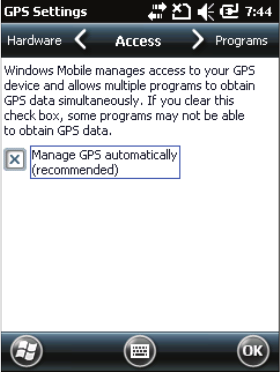
Chapter 1 — Using the CS40
20 CS40 Mobile Computer User’s Manual
3Tap Access and select the Manage GPS automatically check box.
4Tap ok.
Improving GPS Performance on the CS40
The integrated mobile computer GPS module has three operating
modes:
•Standalone-GPS (default)
•Assisted GPS
•Qualcomm XTRA
In Standalone mode, the CS40 GPS module relies solely on GPS
satellites to determine position.
In Assisted GPS mode, the mobile computer can determine position
without receiving GPS signals directly from satellites; instead, the
mobile computer receives GPS signals and information provided by
the cellular network. Even when the mobile computer can receive a
satellite signal, Assisted GPS can improve position accuracy and
reduce the time to determine initial position (Time-To-First-Fix).
Check with your cell phone carrier for availability and pricing for
Assisted GPS service.
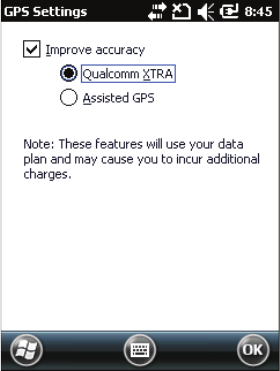
Chapter 1 — Using the CS40
CS40 Mobile Computer User’s Manual 21
Qualcomm XTRA Assistance technology provides enhanced
operation for Standalone-GPS. This option lets the CS40
automatically download a small assistance data file from the XTRA
servers through a brief internet access session.
To improve GPS performance
1Tap Start > Settings > System > GPS Settings.
2Select Improve accuracy and choose an operating mode.
About Additional GPS Options for the Computer
Intermec provides enhanced feature support for the Extended
Ephemeris data capability. For more information about
programming for Extended Ephemeris GPS, visit the Intermec
Developer Library at www.intermec.com/idl.
Chapter 1 — Using the CS40
22 CS40 Mobile Computer User’s Manual

23
2
Connecting and Configuring the CS40
Use this chapter to understand how to configure the mobile
computer to communicate in your network. This chapter
contains these topics:
•How to Configure the CS40
•About SmartSystems Foundation
•How to Connect the CS40 to a PC
•How to Connect the CS40 to Your Network
•About the Phone
•Connecting to an ISP
•Connecting to a Network With a VPN Server
Chapter 2 — Connecting and Configuring the CS40
24 CS40 Mobile Computer User’s Manual
How to Configure the CS40
You can configure many parameters of the CS40, such as the bar code
symbologies it decodes or the network settings. The values you set for
these configuration parameters determine how the CS40 operates.
There are several ways to configure the mobile computer:
•You can use the Scan-to-Connect utility, which is part of
SmartSystems Foundation, to quickly provide the computer with
the minimal information necessary to connect to a secure
network. For more information, see the next section “About
SmartSystems Foundation.”
•You can use a third party device management product that
supports the computer, such as the Microsoft System Center
Mobile Device Manager. For more information, visit the Microsoft
web site at http://msdn.microsoft.com/en-us/default.aspx.
•You can use Imager Configuration Bar codes to enable or disable
symbologies, reset to factory defaults, and set predefined imager
modes. For more information, see “Imager Configuration Bar
Codes” on page72.
About SmartSystems Foundation
SmartSystems™ Foundation is an Intermec software platform that
lets you manage all of your SmartSystems-enabled devices
simultaneously from a central server. The SmartSystems Console
displays all SmartSystems-enabled computers and peripherals in your
network.
Through the Console, you can:
•drag-and-drop configuration bundles, OS updates, and firmware
upgrades to multiple computers.
•create a “golden” device configuration to use when updating other
computers.
•remotely change settings on SmartSystems-enabled computers
and peripherals.
Chapter 2 — Connecting and Configuring the CS40
CS40 Mobile Computer User’s Manual 25
With an AutoDeploy license, SmartSystems can automatically push
software, configuration settings, and other files to connected mobile
computers. AutoDeploy can report on asset locations and battery
status, making it easier to manage your mobile devices. The license
also enables Scan-to-Connect, which makes connecting additional
mobile computers to your secure wireless network as easy as reading
bar codes.
You can download SmartSystems Foundation at no charge from the
Intermec web site. For more information on SmartSystems, go to
www.intermec.com/SmartSystems. To purchase an AutoDeploy
license, contact your local Intermec sales representative.
How to Connect the CS40 to a PC
You can use Microsoft ActiveSync (Windows XP or earlier) or
Windows Mobile Device Center (Windows Vista or Windows 7) to
establish a connection between your CS40 and PC. After you connect
to your PC, you can transfer files, synchronize files, remotely debug,
and perform other device management activities. ActiveSync and
Windows Mobile Device Center are a free applications available from
the Microsoft web site at www.windowsmobile.com/getstarted.
To connect your CS40 and PC, you need to physically connect your
CS40 to your PC using the power and data y-cable accessory.
How to Connect the CS40 to Your Network
The CS40 is a versatile mobile computer that you can easily add to
your wireless or wired data collection network. You can connect your
computer using:
•802.11 radio communications.
•Bluetooth communications.
•Ethernet communications
•USB communications.

Chapter 2 — Connecting and Configuring the CS40
26 CS40 Mobile Computer User’s Manual
Connecting the CS40 Using 802.11 Radio Communications
Your CS40 has an 802.11 radio to transfer data using wireless
communications. This section assumes that your wireless network is
set up, including your access points.
To configure 802.11 radio parameters
1Tap Start > Settings > Connections.
2Tap Wi-Fi. The Wi-Fi page appears.
3If the Network you want to connect to is available in the wireless
networks list, tap the network name and continue with Step 4.
If the Network you want to connect to is not in the wireless
networks list:
aTap Add New. The Configure Wireless Network page appears.
bIn the Network name field, enter the name of your network
and tap Next. The Configure Network Authentication page
appears.
4From the Authentication list, choose either Open, Shared, WPA,
WPA-PSK, WPA2, or WPA2-PSK.
•If you choose Open or Shared, Data Encryption is
automatically set to WEP and the key is automatically
provided.
•If you choose WPA, Data Encryption is automatically set to
TKIP.
•If you choose WPA2, Data Encryption should be set to AES.
•If you choose WPA-PSK, Data Encryption is automatically
set to TKIP and you need to enter a Network key.
•If you choose WPA2-PSK, Data Encryption should be set to
AES and you need to enter a Network key.
Make sure all components with antennas are at least 30 cm (1 ft)
apart when power is applied. Failure to comply could result in
equipment damage.

Chapter 2 — Connecting and Configuring the CS40
CS40 Mobile Computer User’s Manual 27
5Tap Next.
6For EAP type, select either PEAP or Smart Card or Certificate
from the list and tap Finish. You return to the Configure Wireless
Networks page.
7Use the u and d arrow keys to select your network from the list
and tap Connect.
8When prompted, enter this network information:
•User name
•Password
9Tap OK. Your CS40 connects to the network.
10 Make sure that your CS40 is talking to the network and that the
network can see your CS40. If you are connected to the wireless
network, a connected icon ( ) appears on the navigation bar and
the name of your network appears next to Wi-Fi in the Wireless
Manager.
Connecting the CS40 Using Bluetooth Communications
Your CS40 is Bluetooth™-enabled, which lets you connect to other
Bluetooth devices, such as printers.
You need to turn on the Bluetooth radio before you can discover and
connect to other Bluetooth devices. By default, the radio is turned off.
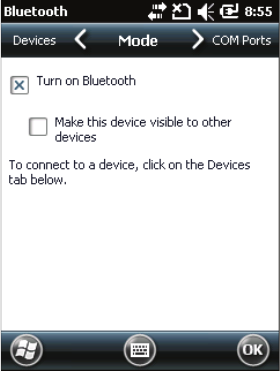
Chapter 2 — Connecting and Configuring the CS40
28 CS40 Mobile Computer User’s Manual
To turn on the Bluetooth radio
1Tap Start > Settings > Bluetooth > Mode.
2Tap the Turn on Bluetooth check box.
3(Optional) If you want your CS40 to be visible to other Bluetooth
devices, tap Make this device visible to other devices.
4Tap ok.
The Bluetooth radio maintains its current state through a warm or
cold boot and maintains virtual COM ports. If you clean boot your v,
you need to recreate pairings to devices.
Connecting the CS40 to a Wireless Printer
To configure your CS40 for Bluetooth wireless printing, you need to:
•make sure Bluetooth power is on. For help, see the procedure in
“Connecting the CS40 Using Bluetooth Communications” on
page27.
•create an application that opens the wireless printing COM port
on your CS40. For help, see the Bluetooth Resource Kit, which is
part of the Intermec Developer Library (IDL), available from the
Intermec web site at www.intermec.com/idl.
•select the current wireless printer on your CS40. For help, see the
next procedure.
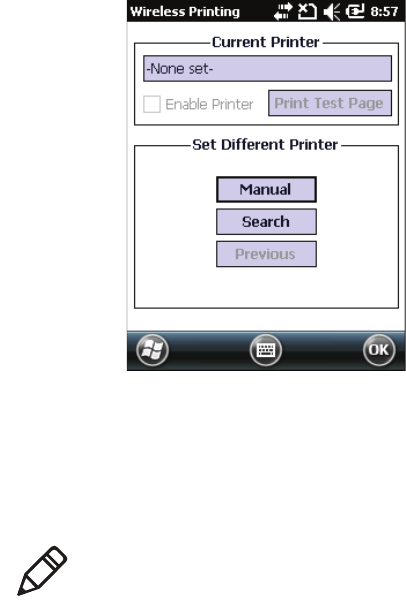
Chapter 2 — Connecting and Configuring the CS40
CS40 Mobile Computer User’s Manual 29
To select the current wireless printer
1Select Start > Settings > System > Wireless Printing.
2Tap Search to find a printer, or tap Manual to enter a device
address. Follow the onscreen instructions to select the current
wireless printer.
3(Optional) Tap Print Test Page. The printer prints out the test
page.
Connecting the CS40 Using Ethernet Communications
You connect your CS40 to your Ethernet network using these
accessories:
•USB Ethernet adapter cable
•Power and data y-cable
Note: You can also print wirelessly from inside your applications
using Microsoft APIs with Bluetooth extensions for Winsock and
Bluetooth virtual COM ports. For help, see the Bluetooth Resource
Kit documentation.

Chapter 2 — Connecting and Configuring the CS40
30 CS40 Mobile Computer User’s Manual
To use your computer in an Ethernet network
1Connect your CS40 to the power and data y-cable.
2Connect the power and data y-cable to the USB connector of the
USB Ethernet adapter cable. Ethernet communications is
automatically enabled on your CS40.
3Make sure that your CS40 is communicating with the network.
You should see the network connection icon ( ) in the
navigation bar.
Connecting the CS40 Using USB Communications
You can use the power and data y-cable accessory to transmit data to
and receive data from a desktop PC through USB communications.
The USB port supports both USB client and USB host. The port
automatically senses the cable you are using and determines which
drivers to use. For more information about this accessory and how to
order it, see “CS40 Accessories” on page3.
About the Phone
Your CS40 supports UMTS mobile wireless phone technology. With
the radio module installed in your CS40, you can send and receive
telephone calls as well as transmit data through wide-area (WAN)
cellular networks.
The CS40 has a phone speaker, microphone, and speakerphone. It
also supports the use of a Bluetooth headset or hands-free kit. The
factory default setting for the phone is disabled.
After you turn on the phone and activate service with your wireless
carrier, you can customize the features of the phone and network
settings. For help, see the online help on your mobile computer.
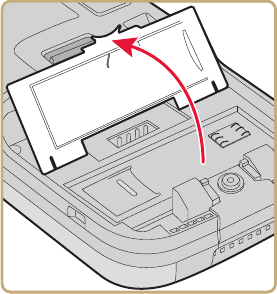
Chapter 2 — Connecting and Configuring the CS40
CS40 Mobile Computer User’s Manual 31
Turning On the Phone Using the Wireless Manager
You can use the Wireless Manager to enable and disable Bluetooth,
Wi-Fi, and the phone on your CS40.
To turn on the phone using the wireless manager
1Tap Start > Settings > Connections > Wireless Manager >
Enable > Phone. The phone turns on.
2Tap the Personal tab, and then tap Phone to configure the
phone. For help, see the next procedure, “Activating the UMTS
Radio.”
3Tap Done to close the Wireless Manager.
Activating the UMTS Radio
You use a SIM card to activate the UMTS/HSPA phone on your CS40.
You can purchase the SIM card from your network provider.
To install the SIM card and activate the UMTS radio
1Tap Start > Shutdown to turn off the CS40.
2Push the battery release tab forward until the battery releases, and
lift the battery away from the computer.
3Open the card access door.
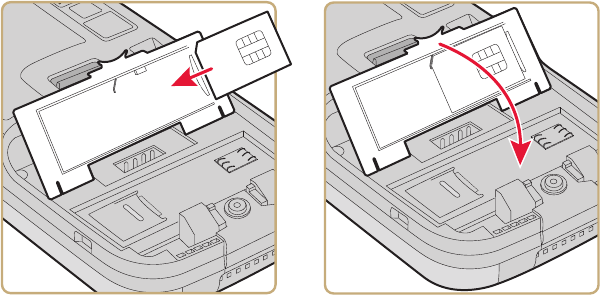
Chapter 2 — Connecting and Configuring the CS40
32 CS40 Mobile Computer User’s Manual
4Slide the SIM card into the slot in the card access door.
5Close the card access door.
6Install the battery.
7Press the Power button. The CS40 cold boots.
Making a Phone Call
After you activate your phone, you are ready to start making phone
calls. The icon on the navigation bar changes to indicate that the
radio is now active.
To make a phone call
1Tap Start > Phone.
2Tap the keys to enter the telephone number you want to call.
3Tap the Talk button.
Connecting to an ISP
You can connect to your Internet Service Provider (ISP), and use the
connection to send and receive e-mail messages and view web pages.
Get an ISP dial-up access telephone number, a user name, and a
password from your ISP.
Tap the Help icon at any time to view additional information for the
wizard or the settings.
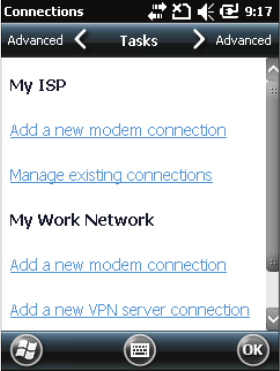
Chapter 2 — Connecting and Configuring the CS40
CS40 Mobile Computer User’s Manual 33
To connect to an Internet service provider
1Tap Start > Settings > Connections.
2Under My ISP, tap Add a new modem connection.
3Enter a name for the connection, such as “ISP Connection.”
4If you are using an external modem connected to your mobile
computer with a cable, select Hayes Compatible on COM1 from
the Select a modem drop-down list.
5Tap Next.
6Enter the access phone number and tap Next.
7Enter the User name, Password, and Domain (if provided by an
ISP or your network administrator).
8Tap Finish.
9From the Connections screen, tap the Advanced tab, and then tap
Dialing Rules.
10 Select Use dialing rules, tap ok at the dialog box, and then tap
Edit.
11 Specify your current phone type and then tap ok until you exit
and return to the Settings page.
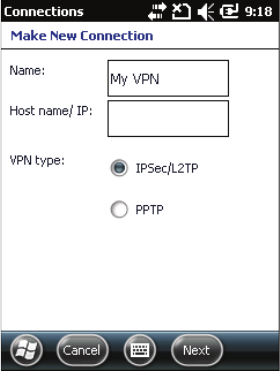
Chapter 2 — Connecting and Configuring the CS40
34 CS40 Mobile Computer User’s Manual
After your mobile computer is connected, you can:
•send and receive message using Messaging (Outlook E-mail).
•visit web pages using Internet Explorer Mobile.
Connecting to a Network With a VPN Server
A VPN connection helps you to securely connect to servers, such as a
corporate network, through the Internet. Before you can make a VPN
connection, you need this information from your network
administrator:
•User name
•Password
•Domain name
•TCP/IP settings
•Host name or IP address of the VPN server
To create a VPN server connection to work
1Tap Start > Settings > Connections.
2Under My Work Network, tap Add a new VPN server
connection.
3Step through the screens to set up your VPN connection.

Chapter 3 — Developing and Installing Applications
36 CS40 Mobile Computer User’s Manual
How to Develop Applications for the CS40
Use the Intermec Resource Kits to develop new applications to run on
your CS40. The Resource Kits are a library of components grouped by
functionality that you can use to create applications for your CS40.
The Resource Kits are part of the Intermec Developer Library (IDL),
and you can download them from the Intermec web site at
www.intermec.com/idl.
To use the Resource Kits, you need Microsoft Windows Mobile SDK
and Microsoft Visual Studio 2005. For more information on IDL, see
the Intermec Developer Library Resource Kit Developer’s Guide.
How to Package Your Application
For very simple applications, the executable file may be the only file
you need to deploy. More typically, you will have a set of files to
install.
Intermec recommends using .cab files to install your applications.
The CN4 uses standard Windows Mobile .cab files and will install
third-party .cab files.
How to Choose a Target Location
You can have your .cab file place your application in any of these
memory locations on the CN4:
•The ObjectStore.
•The optional miniSD card. Depending on available disk space, you
may want to consider installing your application files on the
miniSD card. Using a card creates the Storage Card folder on the
CN4.
•The non-volatile Flash File Store. Applications and data in the
Flash File Store will persist through a clean boot.
Note: The Flash File Store may be erased if you reflash the image.
Chapter 3 — Developing and Installing Applications
CS40 Mobile Computer User’s Manual 37
Files copied to any of these locations are safe when you cold boot
the computer as long as the AutoRun system is installed in the
appropriate location. When AutoRun is installed on the computer,
all .cab files in the CabFiles folder are automatically extracted after a
cold boot. For more information about AutoRun, see the Intermec
Developer Library Resource Kit Developer’s Guide.
How to Install Applications on the CS40
There are several ways you can install files and applications on your
CS40:
•SmartSystems console
•ActiveSync or Windows Mobile Device Center
•Scan to Load hands-free software loading function of
SmartSystems Foundation
•microSD card
For more information about installing applications, see the Intermec
Developer Library Resource Kit Developer’s Guide.
Installing Applications Using SmartSystems Foundation
Console
You can use the SmartSystems Foundation console to drag-and-drop
Intermec applications onto your CS40.
To use SmartSystems Scan-to-Connect to connect your CS40 to your
network and install software, see the SmartSystems Foundation
online Help.
To use SmartSystems console to install an application
1Download your application file from the Intermec web site and
unzip it on your desktop PC.
2Double-click the application file to install it. The application file
should appear in the Software Vault.
3From the SmartSystems console in the Software Vault, drag-and-
drop the application onto each CS40 in your network, or drop the
application on a group of CS40s contained in a folder.
Chapter 3 — Developing and Installing Applications
38 CS40 Mobile Computer User’s Manual
For more information, go to the Intermec web site at
www.intermec.com/SmartSystems.
Installing Applications Using Microsoft ActiveSync or
Windows Mobile Device Center
If you only have a few CS40s to update with applications, you can
copy files using Microsoft ActiveSync or Windows Mobile Device
Center.
To install an application using Microsoft ActiveSync or Windows
Mobile Device Center
1On your PC, copy the .cab file you want to download to your CS40.
2Create an ActiveSync or Windows Mobile Device Center
connection between your PC and your CS40.
3Copy the .cab files from your PC to your CS40.
4Warm boot or cold boot your CS40. For help, see “Resetting the
Computer” on page 50.
5After the boot process is finished, browse to the .cab files and tap
the files to install them.
How to Install Applications Using a Scan-to-Connect Bar
Code
You can use the Scan-to-Connect function in SmartSystems
Foundation to create a bar code that loads software. The bar code
contains the address of the server where the software to download is
located. Once you scan the bar code, it finds the server, downloads the
file, and installs it on your CS40. For more information on installing
applications using a Scan-to-Connect bar code, see the SmartSystems
Foundation Help.
Installing Applications Using a microSD Card
If your application requires more disk space than your CS40 can
comfortably handle, you can use a microSD card to install
applications.
Chapter 3 — Developing and Installing Applications
CS40 Mobile Computer User’s Manual 39
To install applications using the microSD card
1Tap Start > Shutdown to turn off your CS40.
2Remove the microSD card. For help, see “Inserting a microSD
Card” on page 17.
3Insert the microSD card into a microSD adapter card, and then
place it in the storage card reader connected to your PC.
4Copy your application file to the microSD card.
5Remove the microSD card from the adapter card and insert it into
your CS40.
6On your CS40, navigate to the storage card folder and run your
application.
How to Update the System Software
Your CS40 uses Image Update to update the operating system (OS)
and system software. Image Update uses packages to allow for smaller
and faster updates because the contents are stored in ROM. Packages
persist through a cold or clean boot and cannot be removed by the
end user. The Image Update process also provides strengthened
security because all packages are signed.
Image Update packages (.pkg or .pks files) may contain elements such
as DLLs, executable (.exe) files, and .cab files.
You can use either of these methods to update your CS40:
•You can update multiple computers at the same time using the
SmartSystems Console. For help, see the next section, “Updating
Multiple CS40s Using SmartSystems Console.”
•You can update individual computers by transferring the packages
to your mobile computer and then installing them from the
mobile computer.
If you are using SmartSystems to update your CS40 you can choose to
send the updates silently. For more information, see “How to Send
Silent Update Packages to the Computer” on page 41.

Chapter 3 — Developing and Installing Applications
40 CS40 Mobile Computer User’s Manual
Updating Multiple CS40s Using SmartSystems Console
You can use the SmartSystems console to update the operating
system or system software on your CS40. The console is part of
SmartSystems Foundation and is available from the Intermec web site
through the Intermec Developer Library (IDL). Before you can
upgrade your CS40, you need:
•SmartSystems Foundation. To download SmartSystems
Foundation, go to www.intermec.com/idl and open the Device
Management page.
•the SmartSystems bundles you want to install. The SmartSystems
bundle contains the Image Update package file. These
SmartSystems bundles are available from the Intermec web site at
www.intermec.com. Go to Support > Downloads.
To update your CS40 using SmartSystems Foundation
1Open the SmartSystems console.
2Make sure the SmartSystems console and your CS40 are on the
same subnet and connected wirelessly or through Ethernet.
3Make sure that power management is disabled on your CS40.
4Download the SmartSystems bundle to your PC.
5Double-click the SmartSystems bundle on your PC to extract the
update files to the software vault.
6From the SmartSystems console, locate the bundle(s) to install.
7Drag the application to each mobile computer you want to update
or to a group of mobile computers in a folder. The SmartSystems
console installs the update on your computers.
8After the download is complete, your mobile computer begins the
update process and automatically performs a cold boot.
The mobile computer then boots into a special Update Loader
mode where the computer has no connections and is completely
unusable. This process can take anywhere from 30 seconds to 15
minutes depending on the update.
Note: The SmartSystems console indicates that your mobile
computer is offline, by displaying a red stop sign symbol, until the
mobile computer reboots and reconnects to the system.
Chapter 3 — Developing and Installing Applications
CS40 Mobile Computer User’s Manual 41
9After the update is complete, your mobile computer cold boots
again. When a confirmation dialog box appears requesting user
input, dismiss it.
How to Send Silent Update Packages to the Computer
If you want to automatically download and send update packages to
your CS40, you can purchase a SmartSystems AutoDeploy License.
The silent updates do not require any user intervention and begin
when you choose to have the update process start. SmartSystems
Foundation users are notified when update packages are released so
that they can download them and update their Intermec computers.
For more information, see the SmartSystems Foundation Help.
Updating Individual CS40s
You can download update packages from your PC to your CS40 using
Microsoft ActiveSync (Windows XP or earlier), Windows Mobile
Device Center (Windows Vista or Windows 7), or any other file
transfer method you choose.
To update an individual CS40
1Download the Image Update packages you want to install from
the Intermec web site at www.intermec.com. Go to Support >
Downloads.
2Transfer the Image Update packages from your PC to your CS40.
3On your CS40, tap Start > File Explorer and navigate to the
location of the Image Update package.
4Double-tap the package to install it. Your CS40 validates the
update package and prompts you to continue with installation.
5Tap Install.
Your CS40 boots and enters a special Update Loader mode where
the computer has no connections and is completely unusable. This
process can take anywhere from 30 seconds to 15 minutes
depending on the update.
6When the installation is complete, an Update Result page appears.
Tap Done.
Chapter 3 — Developing and Installing Applications
42 CS40 Mobile Computer User’s Manual

43
4
Troubleshooting and Maintaining the
Computer
If you encounter any problems while using the mobile computer,
look in this chapter to find a possible solution. You will also find
information on routine maintenance. This chapter contains
these sections:
•Calling Product Support
•Troubleshooting the Computer
•Resetting the Computer
•Cleaning the Computer
Chapter 4 — Troubleshooting and Maintaining the Computer
44 CS40 Mobile Computer User’s Manual
Calling Product Support
If you cannot find the answer to your problem in the
“Troubleshooting the Computer” section, you can visit the
Intermec technical knowledge base (Knowledge Central) at
intermec.custhelp.com to review technical information or to request
technical support. If you still need help after visiting Knowledge
Central, you may need to call Product Support.
To talk to an Intermec Product Support representative, call
1-800-755-5505.
Before you call Intermec Product Support, make sure you have the
following information ready:
•Configuration number
•Serial number
•Firmware and software version numbers
•Know the language your custom application was written in and
the tools you used to create it
Consult your application developer for information on your custom
application.
To find your configuration number and serial number
•Look at the CN (configuration number) and SN (serial number)
fields on the label inside the battery compartment.
To find software and firmware version numbers
1Go to Start > Settings > About.
2Tap the Packages tab to find software version numbers.
3Tap the Build tab to find the firmware version.

Chapter 4 — Troubleshooting and Maintaining the Computer
CS40 Mobile Computer User’s Manual 45
Troubleshooting the Computer
Use this section to troubleshoot some common problems you may
experience with your CS40.
Note: If you send your CS40 in for service, it is your responsibility to
save the computer data and configuration. Intermec is responsible
only for ensuring that the hardware matches the original
configuration when repairing or replacing the computer.
Problems While Configuring the Mobile Computer
Problem Possible Solution
You cannot type a
character on the
keypad or you can
only type uppercase
or lowercase letters.
You may have locked a modifier key on the keypad.
Press the necessary key sequence to unlock the key.
For help, see “About the Keypad ” on page8.
You press ^ and
nothing happens.
•Make sure the backlight is on.
•The battery may be discharged. Replace the battery
with a spare charged battery, or charge the battery.
•Reset the mobile computer. For help, see
“Resetting the Computer” on page50.
You insert a
microSD card and
cannot find the
microSD card folder
on the CS40.
•The microSD card may not be installed correctly.
Insert the microSD card as described in “Inserting
a microSD Card” on page17.
•The microSD card may be damaged. Try another
microSD card.
The Battery status
LED is on.
•If the battery status LED is a steady green, the
battery is more than 95% charged and computer is
on a charger.
•If the battery status LED is blinking red, then the
battery is low. Replace or charge the battery.
•If the battery status LED is a steady red, the main
battery is on charge.

Chapter 4 — Troubleshooting and Maintaining the Computer
46 CS40 Mobile Computer User’s Manual
The computer
appears to be locked
up and you cannot
enter data.
•Press and hold the power key to turn off the
mobile computer, and then press the power key
again to turn it on.
•Cold boot the mobile computer. For help, see
“Cold Booting the Computer” on page50.
•Try reloading the firmware. For help, see “How to
Update the System Software” on page39.
•If the mobile computer does not boot or reset,
contact your Intermec representative for help.
You tap the screen
and nothing
happens.
•Make sure the mobile computer is not locked.
•Align your touch screen.
Problems With Wireless Connectivity
Problem Possible Solution
The mobile
computer is
connected to the
network, and you
move to a new site to
collect data. Now,
your mobile
computer is not
connected to the
network.
Move closer to an access point or to a different
location to reestablish communications until you
reconnect with the network. Any data collected while
the mobile computer is out of range is transmitted
over the network once the network reconnects.
The mobile
computer appears to
be connected to the
network, but the
host computer is not
receiving any
information from
the mobile
computer.
There may be a problem with the connection between
the access point and the host computer. Check with
network administrator or use your access point user’s
manual.
Problems While Configuring the Mobile Computer
Problem Possible Solution

Chapter 4 — Troubleshooting and Maintaining the Computer
CS40 Mobile Computer User’s Manual 47
Problems While Configuring 802.1x Security
Problem Possible Solution
The mobile
computer indicates
that it is
authenticated,
but it does not
communicate with
the host.
Make sure the mobile computer IP address, host IP
address, subnet mask, default router are configured
for the network.
The mobile
computer does
not appear to be
authenticating and a
network connection
icon does not appear
on the toolbar.
•The mobile computer may not be communicating
with the access point. Make sure the mobile
computer network name matches the access point
network name (SSID).
•The 802.1x security network may not be active.
Make sure the server software is properly loaded
and configured on the server PC. See server
software documentation for help.
A network
connection icon
appears in the
toolbar, but then
disappears.
•The mobile computer may not be communicating
with the intended access point. Make sure the
mobile computer network name matches the
access point network name.
•The access point may not be communicating with
the server. Ensure the access point is turned on,
properly configured, and has 802.1x security
enabled.
You are setting up
multiple access
points in a network,
with different SSIDs,
and the connection
fails.
When you change the SSID, the WEP key values are
not saved. Configure the WEP key values and save
your changes.

Chapter 4 — Troubleshooting and Maintaining the Computer
48 CS40 Mobile Computer User’s Manual
The mobile
computer
indicates it is not
authenticated.
Make sure that:
•the User Name and Password parameters on the
mobile computer match the user name and
password on the authentication server. You may
need to configure the password on both the
mobile computer and the authentication server.
•on your authentication server, the user and group
are allowed and the group policy is allowed to log
into the server. For help, see the documentation
that shipped with your authentication server
software.
•the IP address and secret key for the access point
match the IP address and secret key on the
authentication server. You may need to configure
the IP address and secret key on both your access
point and authentication server.
•the authentication server software is running on
the server PC.
You clean boot the
mobile computer
and this message
appears, “The server
certificate has
expired or your
system date is
incorrect.”
When you clean boot the mobile computer, the date
and time are not saved. Configure the date and time
and save your changes.
Problems While Scanning Bar Codes
Problem Possible Solution
You press the Scan
button, but you
cannot see a red
beam of light.
•You may be too far away from the bar code label.
Try moving closer to the bar code label and scan it
again.
•You may be scanning the bar code label “straight
on.” Change the scanning angle and try again.
•Move within two feet of a wall to test the effective
scan of the imager. For help scanning bar codes,
see “Reading Bar Codes” on page13.
Problems While Configuring 802.1x Security (continued)
Problem Possible Solution

Chapter 4 — Troubleshooting and Maintaining the Computer
CS40 Mobile Computer User’s Manual 49
When you release
Scan button, the
Good Read LED
does not turn off.
If the mobile computer is configured to use
continuous/edge triggering, the Good Read LED
stays on.
If the mobile computer is configured to use level
triggering, there may be a problem. Press the Scan
button again without scanning a bar code label. If the
LED is still on, contact your local Intermec
representative.
The imager does not
read the bar code
label.
•Aim the scanning beam so that it crosses the entire
bar code label in one pass. Try changing the scan
angle.
•Check the quality of the bar code label, Scan a bar
code label that you know scans well. Compare the
two bar code labels to see if the bar code quality is
too low. You may need to replace the label that you
cannot scan.
•Make sure the bar code symbology is enabled. For
help, see the Data Collection Resource Kit which is
part of IDL. You can download the resource kit
from www.intermec.com/idl.
•Make sure the application is accepting input by
scanning a bar code. You may need to type this
information instead.
The imager does not
read the bar code
labels quickly, or the
scanning beam
seems to be faint or
obscured.
The imager window may be dirty. Clean the window
with a solution of ammonia and water. Wipe dry. Do
not allow abrasive material to touch the window.
The scanned bar
code data that
appears in your
application does
not match the data
encoded in the bar
code label.
The mobile computer may have decoded the bar code
label in a different bar code symbology. Try scanning
the bar code label again. Make sure you scan the
entire label.
Problems While Scanning Bar Codes (continued)
Problem Possible Solution

Chapter 4 — Troubleshooting and Maintaining the Computer
50 CS40 Mobile Computer User’s Manual
Resetting the Computer
You rarely need to reset the mobile computer. If the CS40 does not
resume after pressing the Power button, or if the CS40 or an
application locks up, you may need to reset the CS40. The CS40 uses
the configuration currently saved in flash memory during the boot
process. There are three ways to reset the computer:
•Warm booting
•Cold booting
•Clean booting
Warm Booting the Computer
You may need to perform a warm boot to correct conditions when an
application stops responding to the system.
To warm boot the computer
1Tap Start > Shutdown. The CS40 systematically shuts down.
2Press the Power button to turn on the CS40. The CS40 goes
through the initialization process and restarts.
Cold Booting the Computer
In some cases when the computer completely stops responding, it
may be necessary to perform a cold boot. Because cold booting may
result in data loss, only use this method if all other recovery methods
have failed.
To cold boot your computer
1Remove the battery pack from the computer and wait 30 seconds.
2Install the battery pack and press ^.
Note: Cold booting the computer does not guarantee that cached disk
data will be saved, so transactional data may be lost during the reset.
All other data is preserved.
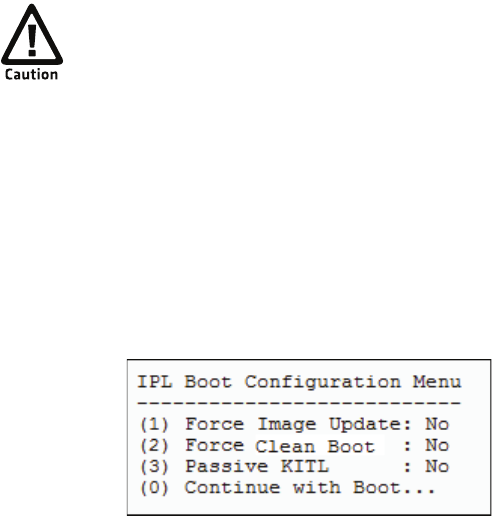
Chapter 4 — Troubleshooting and Maintaining the Computer
CS40 Mobile Computer User’s Manual 51
Clean Booting the Computer
If the computer does not warm boot or cold boot, you may need to
perform a clean boot. When you clean boot the computer, the
computer only loads files and applications that are absolutely
required by the operating system. A clean boot returns the computer
to an “out of the box” or factory default state, so that you can run
diagnostic tests to troubleshoot the normal boot process.
To clean boot the computer
1Remove the battery pack.
2Install the battery pack and press ^.
3When the computer starts the boot process, simultaneously press
< and > until the IPL Boot Configuration Menu appears on the
screen.
4Press 2 to select Force Clean Boot and then press 0 to select
Continue with Boot.
The computer executes the clean boot. This process takes a few
minutes.
5When prompted, tap the screen to set up the computer.
6Follow the instructions to calibrate the screen.
The clean boot process erases the mobile computer memory,
including all applications and data files in the object store. To
preserve applications through a clean boot, store them in the
Flash File Store. For more information, see “How to Install
Applications on the CS40” on page37.

Chapter 4 — Troubleshooting and Maintaining the Computer
52 CS40 Mobile Computer User’s Manual
Cleaning the Computer
To keep the computer in good working order, you may need to
perform these minor maintenance tasks:
•Clean the imager window.
•Clean the computer screen.
Clean the imager window and computer screen as often as needed for
the environment in which you are using the computer. To clean the
computer, use a solution of one part ammonia and 3 parts water.
To clean the imager window and computer screen
1Press ^ to turn off the computer.
2Dip a clean towel or rag in the ammonia solution and wring out
the excess. Wipe off the imager window and screen. Do not allow
any abrasive material to touch these surfaces.
3Wipe dry.
There are no user-serviceable parts inside the computer. Opening
the unit will void the warranty and may cause damage to the
internal components.

53
A
Specifications
Appendix A — Specifications
54 CS40 Mobile Computer User’s Manual
Physical and Environmental Specifications
Physical Dimensions
Length: 13.1 cm (5.2 in)
Width (at widest part): 6.2 cm (2.4 in)
Height (at tallest part): 2.4 cm (0.9 in)
Weight (with battery): 200 g (7.1 oz)
Power and Electrical Specifications
Operating: Rechargeable lithium-ion battery
Battery capacity: 1480 mAh (7.4 Wh)
Electrical rating: x 5 V, 1,5 A
Temperature and Humidity Specifications
Operating temperature: -10°C to 50°C (14°F to 122°F)
Storage temperature: -20°C to 70°C (-4°F to 158°F)
Charging temperature: 0°C to 45°C (32°F to 113°F)
Relative humidity (operating): 5 to 95% non-condensing
Environmental rating: IP54
Screen Specifications
•240 RGB x 320 pixels
•7.1 cm (2.8 in) diagonal square active area
•LED backlight with 5 levels of brightness, including Off
•LCD capable of both portrait and landscape operation
Keypad Options
•Numeric keypad
•Alphanumeric keypad (QWERTY)
Appendix A — Specifications
CS40 Mobile Computer User’s Manual 55
Bar Code Symbologies
The EA11 imager supports these bar code symbologies:
CS40 Micro-AB USB Connector Specifications
The CS40 has a standard Micro-AB USB connector:
•1A maximum charge when using the universal cell phone charger
accessory
•maximum VBUS output power of 5 V @ 100 mA
•AustraliaPost •GS1 DataBar Omnidirectional
•Aztec •Infomail
•BPO (British Post 4-state) •Interleaved 2 of 5
•ChinaPost •JapanPost
•CanadaPost •KoreanPost
•Codabar •Matrix 2 of 5
•Codablock A •Maxicode
•Codablock F •Micro PDF417
•Code 11 •MSI
•Code 39 •PDF417
•Code 93 •Planet
•Code 128/GS1-128 •Plessey
•DataMatrix •Postnet
•DutchPost •QR Code
•EAN/UPC •Standard 2 of 5
•GS1 Composite •SwedenPost
•GS1 DataBar Expanded •Telepen
•GS1 DataBar Limited •TLC 39
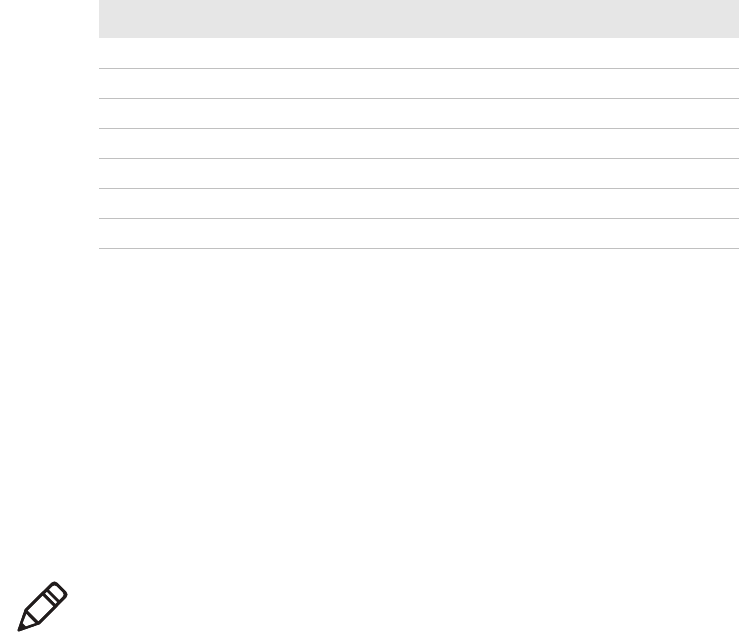
Appendix A — Specifications
56 CS40 Mobile Computer User’s Manual
CS40 Docking Connector Specifications
The CS40 has an array of seven pin surface contacts that provide USB
“On the Go” (OTG) connectivity and charge power while docked.
EA11 Imager Reading Distances
Typical reading distances are done in an office environment using
office lights (4 lux). Minimum distances are measured in the dark
(0 lux). Both reading distances are provided in respective scan engine
integration guides. Contact your local Intermec representative for
more information.
Below are the typical and minimum standard reading distances for
the CS40 built with an EA11 imager. When correctly mounted, an exit
window reduces reading distances by about 4% for all scan engines.
CS40 Docking Connector Specifications
Pin Number Signal Name Description
1 VEXT Computer power
2 ID Identification pin
3 VBUS VBUS (5 V @ 100 mA max)
4D- USB data signal
5D+ USB data signal
6 GND Ground (power return)
7 GND Ground (power return)
Note: Minimum distances depend on the length of the bar code.
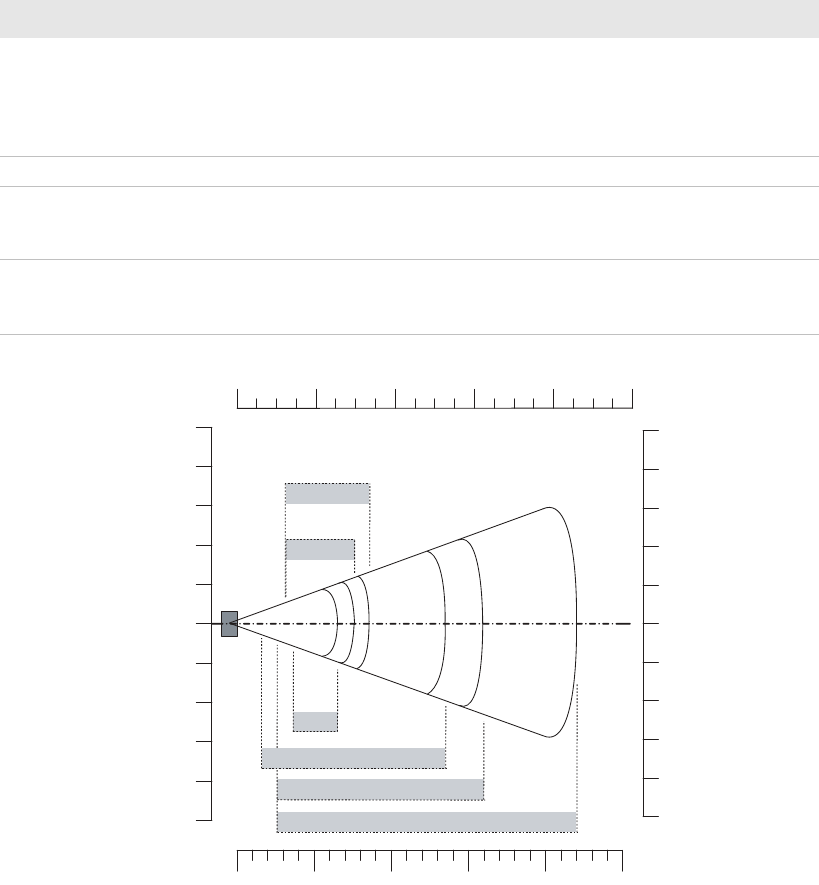
Appendix A — Specifications
CS40 Mobile Computer User’s Manual 57
EA11 Standard Typical Reading Distances
EA11 Standard Typical Reading Distances
Symbology Density Minimum Distance Maximum Distance
Code 39 0.125 mm (5 mil)
0.20 mm (8 mil)
0.25 mm (10 mil)
0.50 mm (20 mil)
1 mm (40 mil)
7.2 cm (2.8 in)
3.8 cm (1.5 in)
3.4 cm (1.3 in)
5 cm (2 in)
8 cm (3.1 in)
13.1 cm (5.1 in)
22.5 cm (8.8 in)
27 cm (10.5 in)
44 cm (17.2 in)
83 cm (32.4 in)
UPC/EAN 0.33 mm (13 mils) 5 cm (2 in) 32 cm (12.5 in)
Data Matrix 0.191 mm (7.5 mils)
0.254 mm (10 mils)
0.381 mm (15 mils)
6.3 cm (2.5 in)
4.8 cm (1.9 in)
*
17.3 cm (6.7 in)
22 cm (8.6 in)
29 cm (11.3 in)
PDF417 0.168 mm (6.6 mils)
0.254 mm (10 mils)
0.381 mm (15 mils)
6.25 cm (2.46 in)
4.5 cm (1.8 in)
4 cm (1.6 in)
15.4 cm (6 in)
23 cm (9 in)
37 cm (14.4 in)
8"
4"
6"
2"
0"
2"
4"
in
6"
8"
10"
10"
cm
10
5
0
5
10
15
20
20
15
25
25
05040302010
0" 20"16"12"8"4"
PDF417 6.6 mils
0.125mm/5mils
0.25 mm / 10 mils
0.5 mm / 20 mils
Data Matrix 7.5 mils
100% contrast UPC EAN
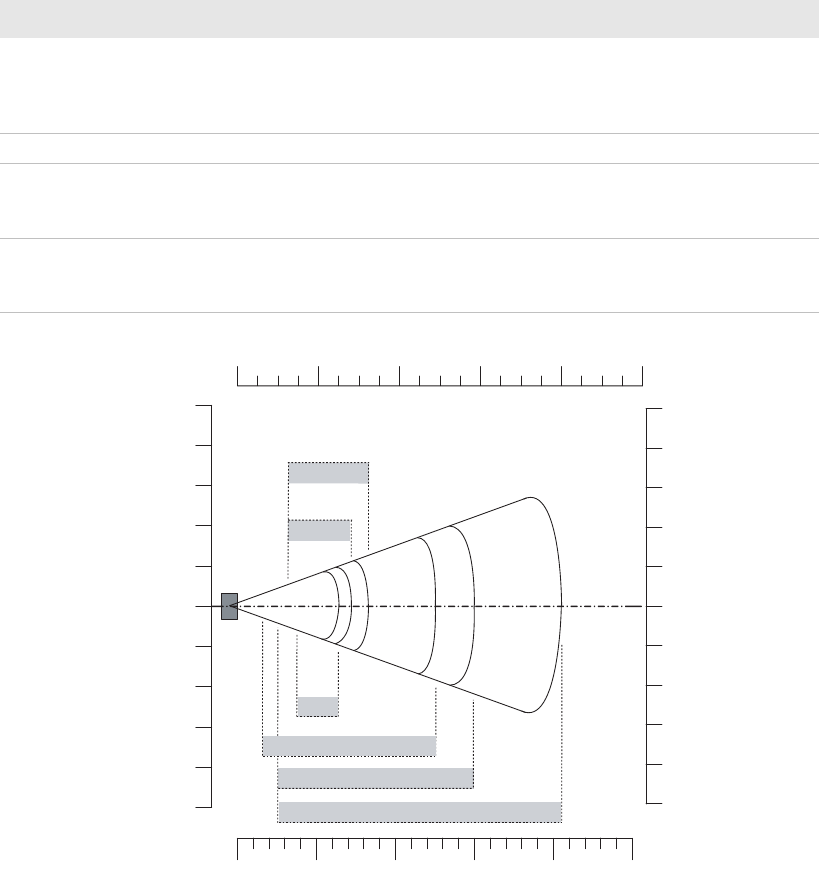
Appendix A — Specifications
58 CS40 Mobile Computer User’s Manual
*
EA11 Standard Minimum Reading Distances
EA11 Standard Minimum Reading Distances
Symbology Density Minimum Distance Maximum Distance
Code 39 0.125 mm (5 mil)
0.20 mm (8 mil)
0.25 mm (10 mil)
0.50 mm (20 mil)
7.26 cm (2.86 in)
3.96 cm (1.56 in)
3.45 cm (1.36 in)
4.98 cm (1.96 in)
12.09 cm (4.76 in)
20.98 cm (8.26 in)
25.04 cm (9.86 in)
40.28 cm (15.86 in)
UPC/EAN 0.33 mm (13 mils) 4.98 cm (1.96 in) 29.62 cm (11.66 in)
Data Matrix 0.191 mm (7.5 mils)
0.254 mm (10 mils)
0.381 mm (15 mils)
3.71 cm (2.46 in)
5.98 cm (2.35 in)
*
16.41 cm (6.46 in)
20.73 cm (8.16 in)
27.58 cm (10.86 in)
PDF417 0.168 mm (6.6 mils)
0.254 mm (10 mils)
0.381 mm (15 mils)
6.25 cm (2.46 in)
4.47 cm (1.76 in)
4.98 cm (1.96 in)
13.87 cm (5.46 in)
21.74 cm (8.56 in)
33.43 cm (13.16 in)
8"
4"
6"
2"
0"
2"
4"
in
6"
8"
10"
10"
cm
10
5
0
5
10
15
20
20
15
25
25
0 5040302010
0" 16"12"8"4"
PDF417 6.6 mils
0.125mm / 5mils
0.25 mm / 10 mils
0.5 mm / 20 mils
Data Matrix 7.5 mils
100% contrast UPC EAN

59
B
Default Settings

Appendix B — Default Settings
60 CS40 Mobile Computer User’s Manual
Default Configuration
The following tables list the default values of the configuration
commands supported on the mobile computer. If you restore the
computer to factory default settings, the computer uses these values.
The commands are grouped by function and reflect the organization
of Intermec Settings. You can configure your computer with Intermec
Settings from the SmartSystems Foundation console. For detailed
information on most of the commands, see the Intermec Settings
Command Reference Manual.
Data Collection
Symbology Settings
Symbology Default Value
AustraliaPost Disable
Aztec Disable
BPO Disable
CanadaPost Disable
ChinaPost Disable
Codabar Disable
Codablock A Disable
Codablock F Disable
Code 11 Disable
Code 39 Enable
Code 93 Disable
Code 128/GS1-128 Enable
DataMatrix Enable
DutchPost Disable
EAN/UPC Enable UPC A, UPC E,
EAN 8, EAN 13
GS1 Composite Disable
GS1 DataBar Expanded Disable
GS1 DataBar Limited Disable
GS1 DataBar Omnidirectional Disable
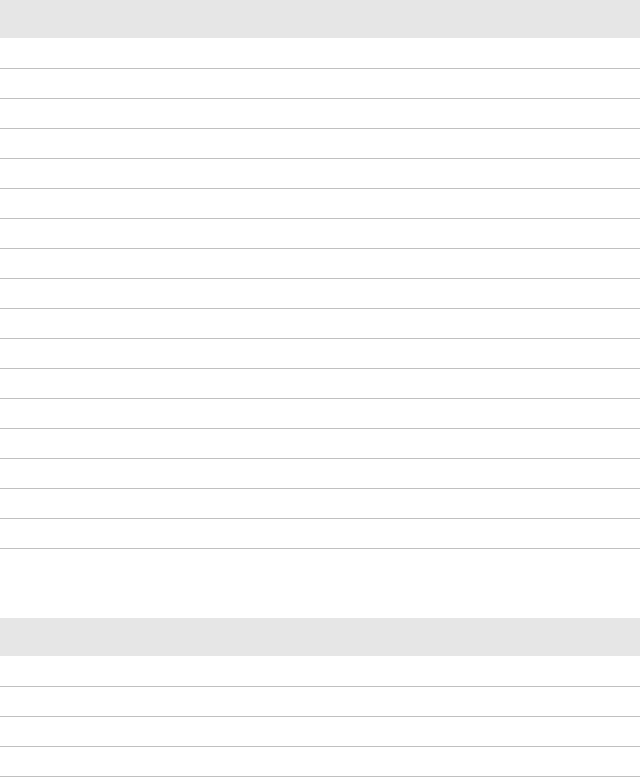
Appendix B — Default Settings
CS40 Mobile Computer User’s Manual 61
Infomail Disable
Interleaved 2 of 5 Disable
JapanPost Disable
KoreanPost Disable
Matrix 2 of 5 Disable
Maxicode Disable
Micro PDF417 Disable
MSI Disable
PDF417 Enable
Planet Disable
Plessey Disable
Postnet Disable
QR Code Disable
Standard 2 of 5 Disable
SwedenPost Disable
Telepen Disable
TLC 39 Disable
Symbology Option Settings
Symbology Option Default Value
Preamble None (disabled)
Postamble None (disabled)
Global Symbology ID Disable
Multicode Disable
Symbology Settings (continued)
Symbology Default Value
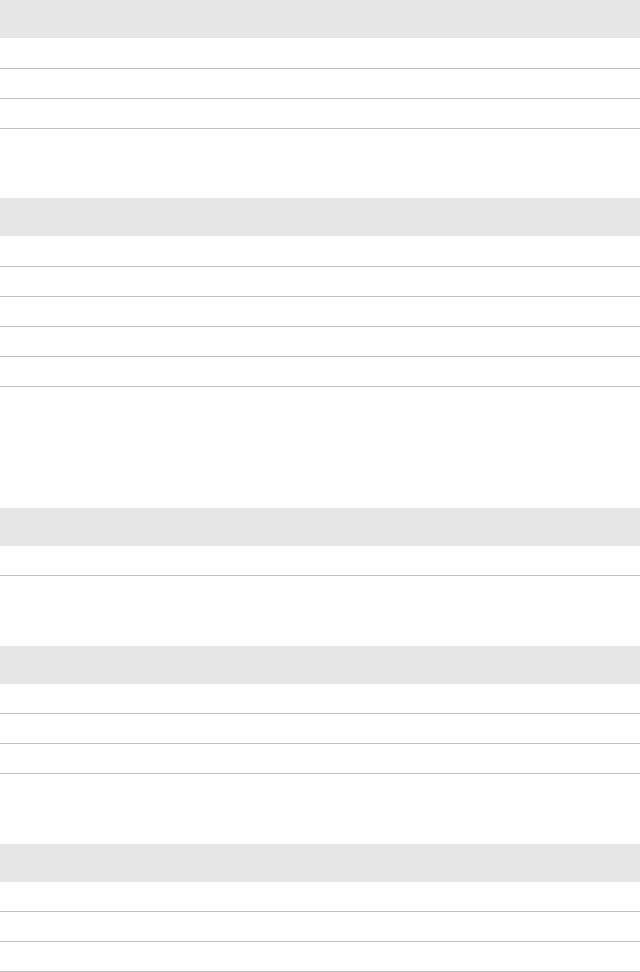
Appendix B — Default Settings
62 CS40 Mobile Computer User’s Manual
Communications
Imager Settings
Imager Setting Default Value
Predefined Modes 1D and 2D Standard
Signature Image Capture Disable
Document Imaging Disable
Decode Security Settings
Decode Security Setting Default Value
Consecutive Data Validation 0
Identical Consecutive Timeout 300 ms
Different Consecutive Timeout 0
Center Decoding Disable
Center Decoding Tolerance 0
Communications Settings
Communications Setting Default Value
Device Name CS40xxxxxxxxxxx
Bluetooth Settings
Bluetooth Setting Default Value
Bluetooth Power Off
Bluetooth Discoverable Disable
Bluetooth Connectable Disable
802.11 Radio Settings
802.11 Radio Setting Default Value
Allow Security Changes Enable
Radio Measurement 0
Radio Enabled Enable
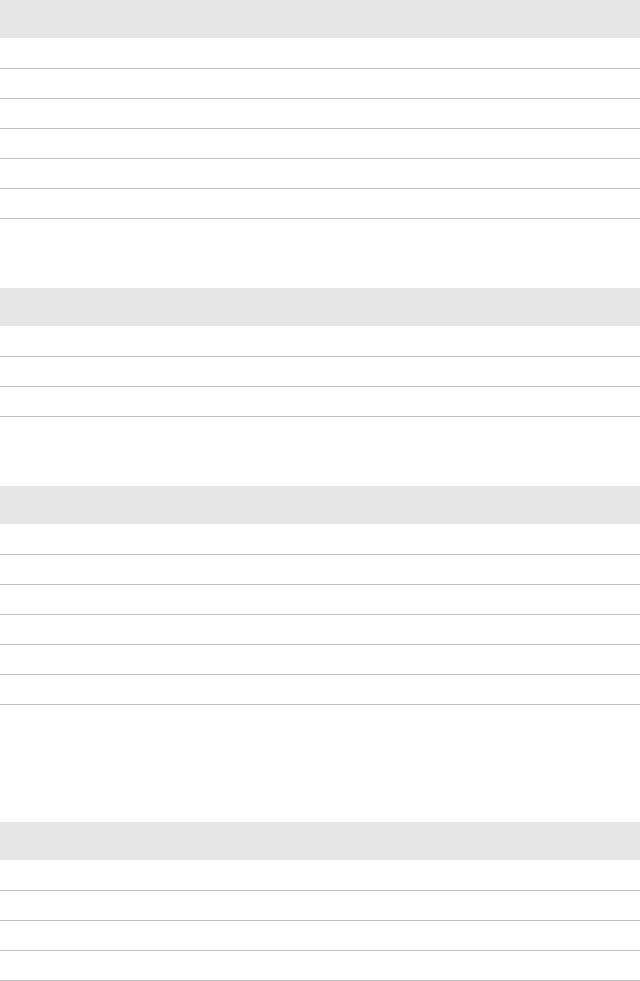
Appendix B — Default Settings
CS40 Mobile Computer User’s Manual 63
Device Settings
Ethernet Adapter Settings
IP Settings Default Value
DHCP Enable
DHCP Client Identifier Null
Primary DNS 0.0.0.0
Secondary DNS 0.0.0.0
Primary WINS 0.0.0.0
Secondary WINS 0.0.0.0
Certificates Settings
Certificates Setting Default Value
Import Root Certificates False
Import User Certificates False
Import Pac Files False
Ethernet Adapter IP Settings
Ethernet Adapter IP Setting Default Value
DHCP Enable
DHCP Client Identifier Null
Primary DNS Null
Secondary DNS Null
Primary WINS Null
Secondary WINS Null
Device Settings
Device Setting Default Value
Date Null
Time Null
Adjust for Daylight Time Disable
Good Read Beep One Beep

Appendix B — Default Settings
64 CS40 Mobile Computer User’s Manual
Beeper Volume Medium
Device Settings (continued)
Device Setting Default Value

65
C
Keypads and Keystrokes

Appendix C — Keypads and Keystrokes
66 CS40 Mobile Computer User’s Manual
Standard Characters
Use the following tables to learn how to enter standard and hidden
characters and functions with the keypad.
Alphanumeric Characters
Character QWERTY Keypad Numeric Keypad
aAc2
bBc22
cC c222
dDc3
eEc33
fF c333
gGc4
hHc44
iI c444
jJc5
kKc55
lL c555
mMc6
nNc66
oO c666
pPc7
qQc77
rR c777
sS c7777
tTc8
uUc88
vV c888
wWc9
xXc99

Appendix C — Keypads and Keystrokes
CS40 Mobile Computer User’s Manual 67
yY c999
zZ c9999
A[A c12
B[B c122
C[C c1222
D[D c13
E[E c133
F[F c1333
G[G c14
H[H c144
I[I c1444
J[J c15
K[K c155
L[L c1555
M[M c16
N[N c166
O[O c1666
P[P c17
Q[Q c177
R[R c1777
S[S c17777
T[T c18
U[U c188
V[V c1888
W[W c19
X[X c199
Y[Y c1999
Z[Z c19999
Alphanumeric Characters (continued)
Character QWERTY Keypad Numeric Keypad
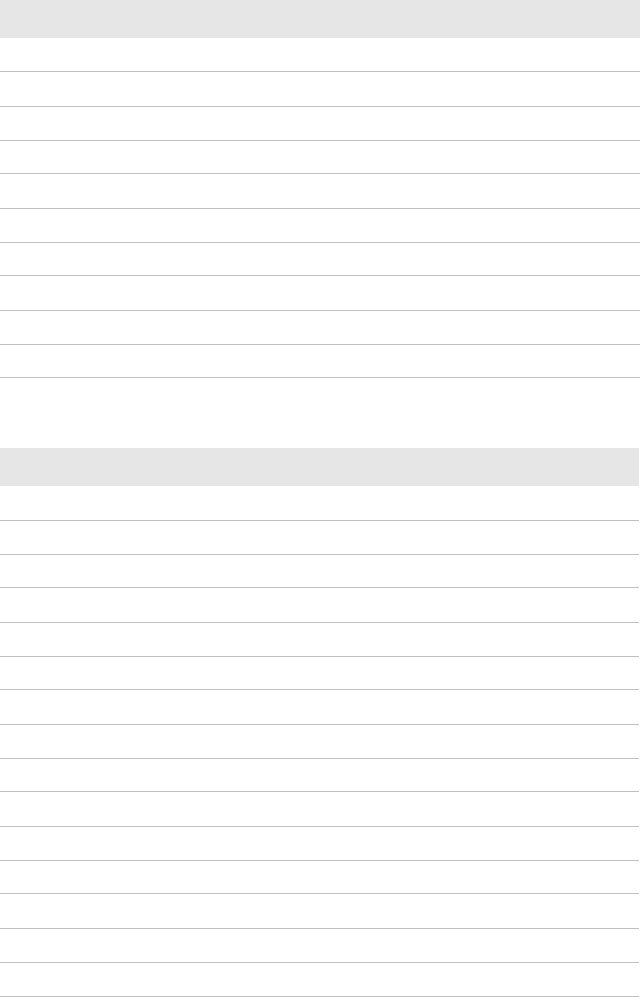
Appendix C — Keypads and Keystrokes
68 CS40 Mobile Computer User’s Manual
0bf 0
1bY 1
2bU 2
3bI 3
4bH 4
5bJ 5
6bK 6
7bB 7
8bN 8
9bM 9
Characters and Functions
Function QWERTY Keypad Numeric Keypad
Forward Tab ii
Back Tab bi bi
Space sc0
Backspace {{
Shift [b or c
Caps Lock b[ c1
Up Arrow uu
Down Arrow dd
Left Arrow b< b<
Right Arrow b> b>
!bO Not available
@bQ Not available
#bV #
$bE Not available
%bR Not available
Alphanumeric Characters (continued)
Character QWERTY Keypad Numeric Keypad
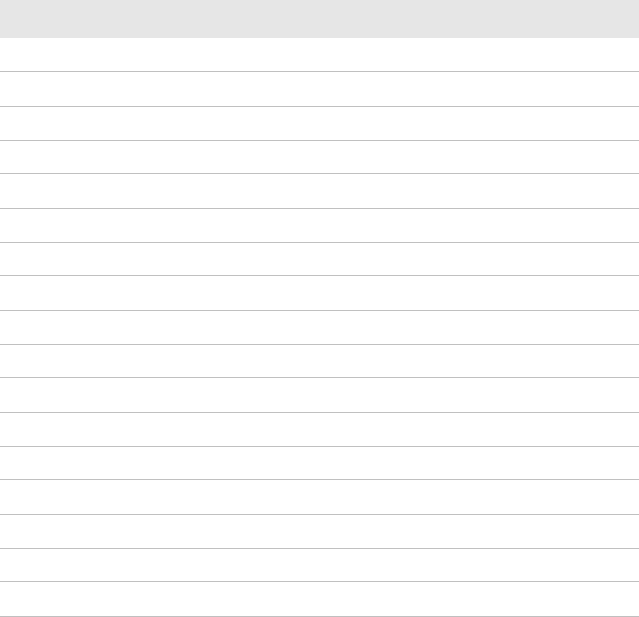
Appendix C — Keypads and Keystrokes
CS40 Mobile Computer User’s Manual 69
&bS Not available
*bC *
+bT b#
ok bP c#
-bG b*
Start (Windows) bW c*
?bA Not available
:bD Not available
/bF Not available
=bL Not available
‘ (apostrophe) bZ Not available
, (comma) bX Not available
. (period) ..
Esc ||
Backlight fb.
Talk pp
End call hh
Characters and Functions (continued)
Function QWERTY Keypad Numeric Keypad
Appendix C — Keypads and Keystrokes
70 CS40 Mobile Computer User’s Manual

71
D
Imager Configuration Bar Codes
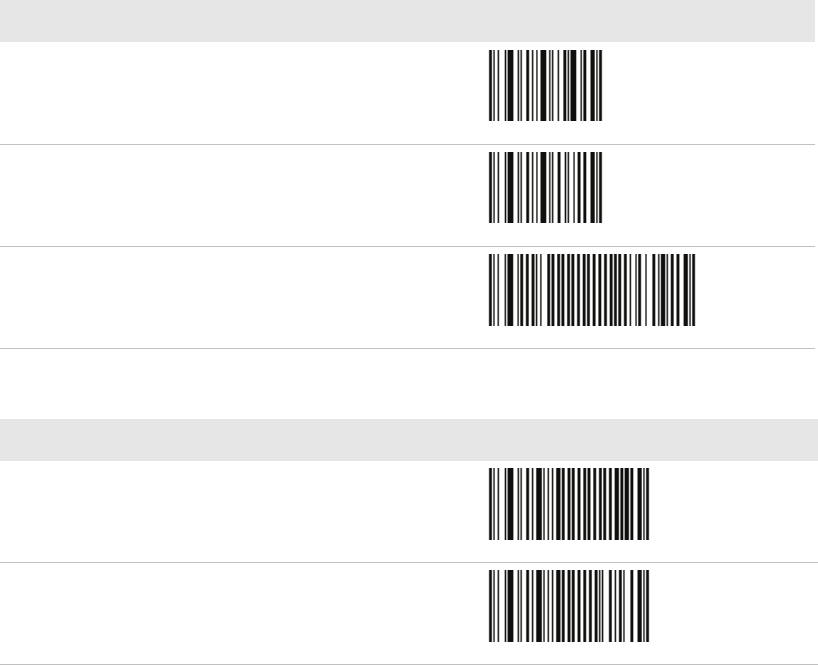
Appendix D — Imager Configuration Bar Codes
72 CS40 Mobile Computer User’s Manual
Imager Configuration Bar Codes
Use the following bar codes to quickly configure the mobile computer
imager. These bar codes allow you to enable or disable symbologies,
reset to factory defaults, and set predefined imager modes.
If you need to create a bar code for a specific setup, please download a
free copy of EasySet from the CS40 web page on the Intermec web site
at www.intermec.com.
Basic Configuration Bar Codes
Command Bar Code
Disable all symbologies
Reset to Factory Defaults
Postamble with Carriage Return and Line Feed
Imager Predefined Modes
Command Bar Code
1D codes only
Standard 1D and 2D codes
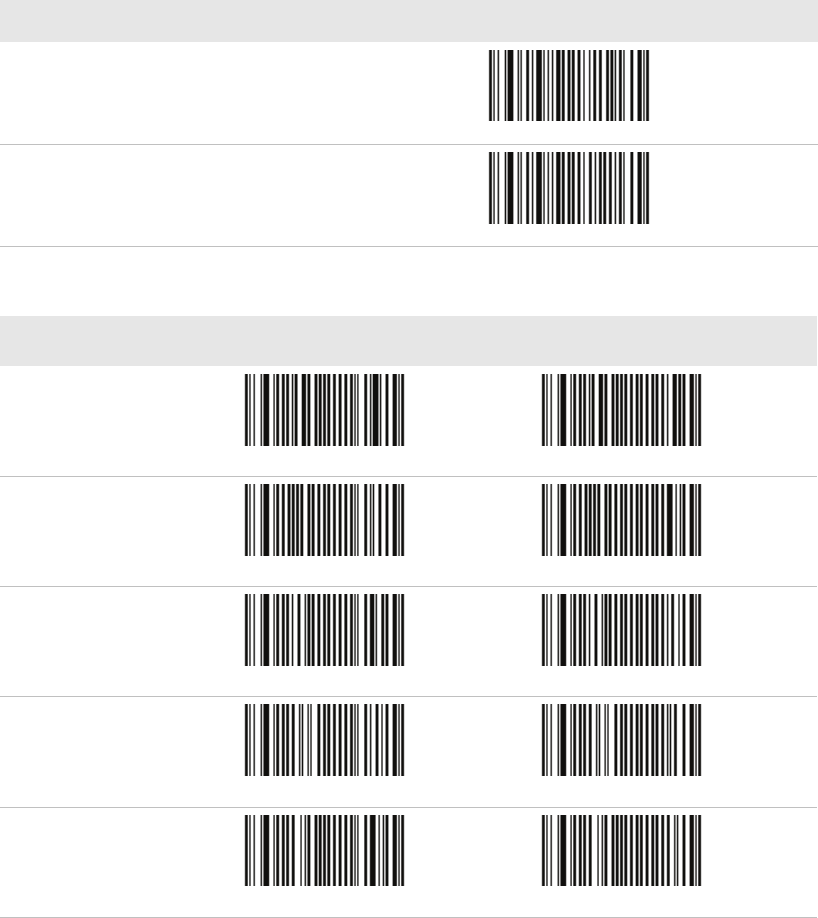
Appendix D — Imager Configuration Bar Codes
CS40 Mobile Computer User’s Manual 73
1D and 2D codes bright environment
1D and 2D codes with reflective surface
Symbology Bar Codes
Symbology Enable Bar Code Disable Bar Code
AustraliaPost
Aztec
BPO
CanadaPost
Codabar
Imager Predefined Modes (continued)
Command Bar Code
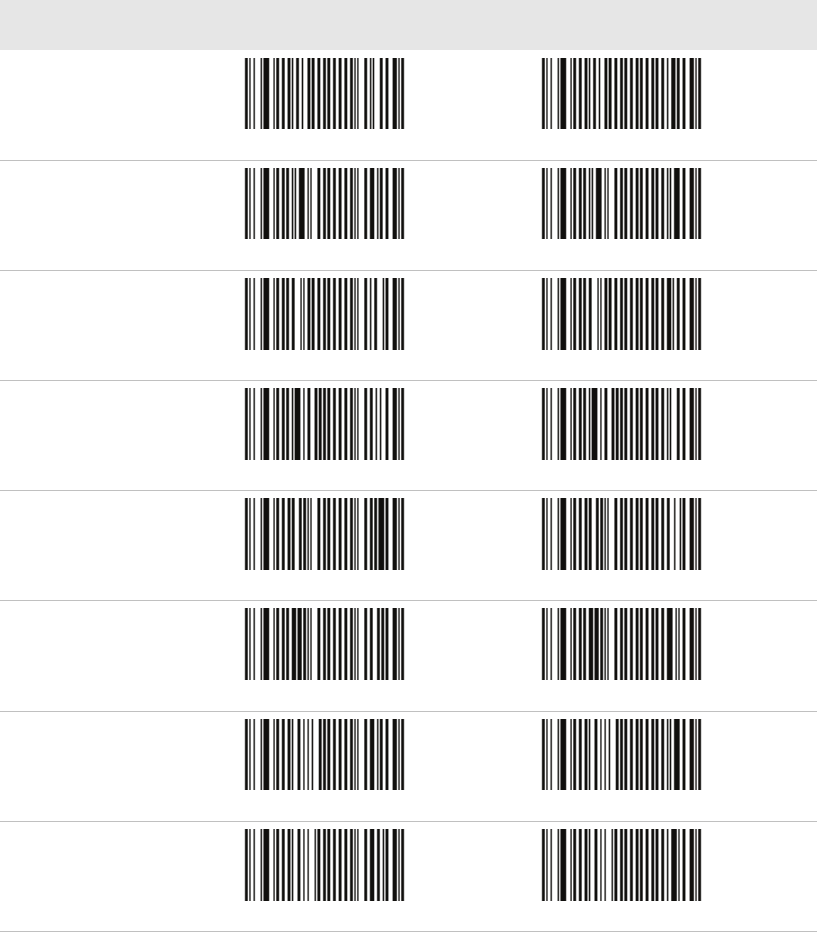
Appendix D — Imager Configuration Bar Codes
74 CS40 Mobile Computer User’s Manual
Code 11
Code 39
Code 93
Code 128
DataMatrix
DutchPost
EAN 8
EAN 13
Symbology Bar Codes (continued)
Symbology Enable Bar Code Disable Bar Code
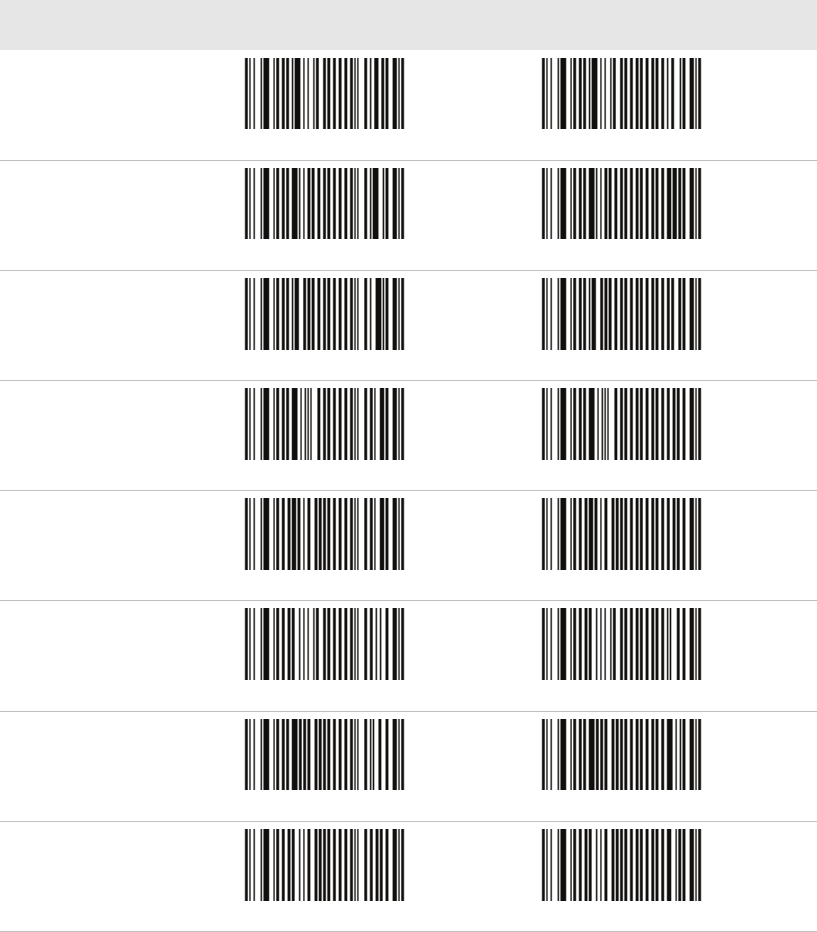
Appendix D — Imager Configuration Bar Codes
CS40 Mobile Computer User’s Manual 75
GS1 128
Interleaved 2 of 5
JapanPost
Matrix 2 of 5
MaxiCode
Micro PDF417
MSI Code
PDF417
Symbology Bar Codes (continued)
Symbology Enable Bar Code Disable Bar Code
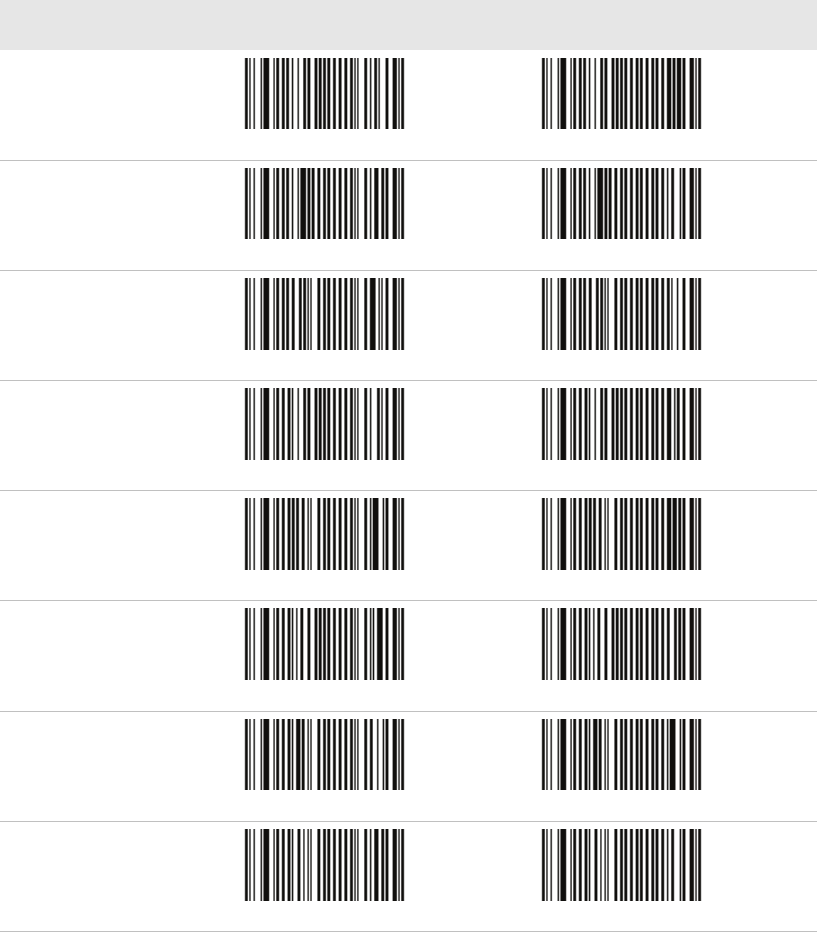
Appendix D — Imager Configuration Bar Codes
76 CS40 Mobile Computer User’s Manual
Planet
Plessey Code
Postnet
QR Code
Standard 2 of 5
Telepen
TLC 39
UPC-A
Symbology Bar Codes (continued)
Symbology Enable Bar Code Disable Bar Code

Appendix D — Imager Configuration Bar Codes
CS40 Mobile Computer User’s Manual 77
UPC-E
UPC-E1
Symbology Bar Codes (continued)
Symbology Enable Bar Code Disable Bar Code
Appendix D — Imager Configuration Bar Codes
78 CS40 Mobile Computer User’s Manual
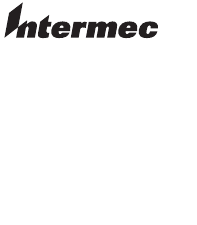
Worldwide Headquarters
6001 36th Avenue West
Everett, Washington 98203
U.S.A.
tel 425.348.2600
fax 425.355.9551
www.intermec.com
© 2010 Intermec Technologies
Corporation. All rights reserved.
CS40 Mobile Computer User’s Manual
*935-037-001*
P/N 935-037-001
